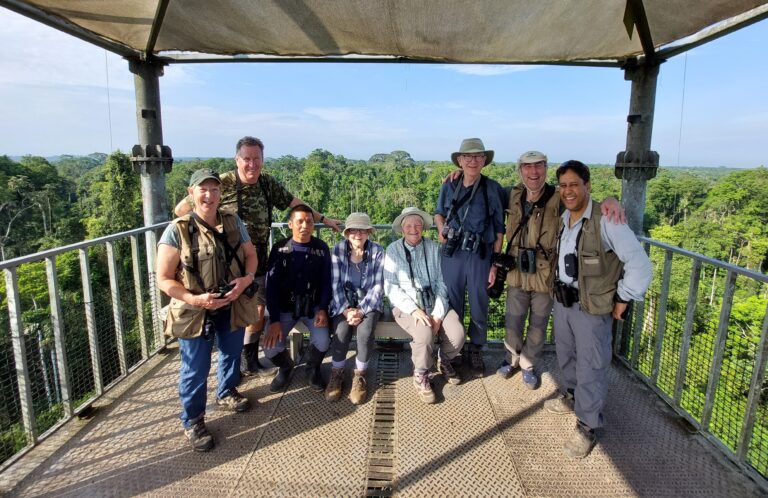
Heading out of Quito, we begin our journey from the lofty Andes down to the mighty Amazon basin, via the top of the Papallacta Pass, some 13330 feet above sea level! Black Vulture is sighting number one, followed by Great Thrush, looking like our Blackbird on steroids! The Polylepis scrub near the top of the pass produces Rufous-collared Sparrow, Brown-bellied Swallow, Scarlet-bellied Mountain Tanager, Variable Hawk, a Tawny Antpitta singing from a low bush in full view and our first ‘hummers’; Tyrian and Viridian Metaltails plus Blue-mantled Thornbill.
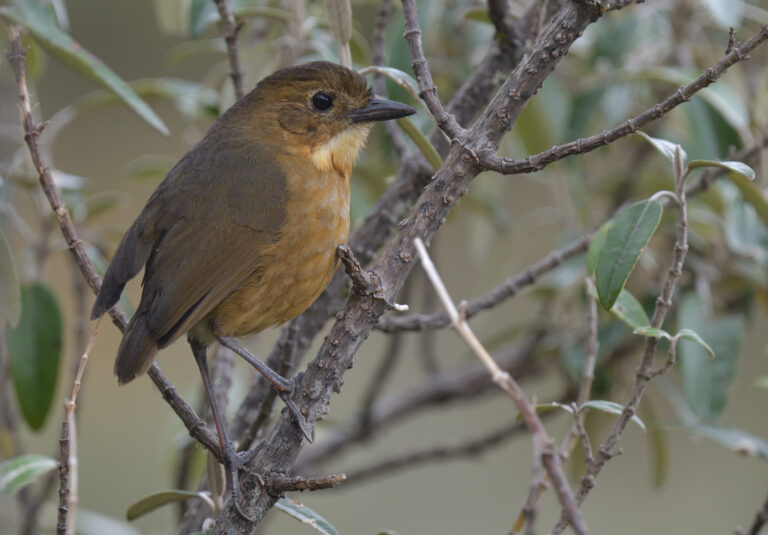
We arrive at the lovely rustic Guango Lodge in time for a nice warm lunch, and spend a damp afternoon on a trail down to the fast flowing Papallacta River, where a pair of Torrent Ducks make light work of the turbulent flow each time they dive in head first from rocks at the edge of the surging current. Also along the trail, we find birds like Northern Mountain Cacique, Spectacled Redstart, Grey-hooded Bush Tanager, Masked Flowerpiercer, Gorgeted Woodstar, Cinnamon Flycatcher and Pearled Treerunner. Back at the lodge, the feeders are buzzing with a variety of frenetic hummers including Chestnut-breasted and Buff-tailed Coronets, Collared Inca, Long-tailed Sylph, the tiny White-bellied Woodstar, the amazing Sword-billed Hummingbird, which has to be seen to be believed, and Tourmaline Sunangel, one of which actually lands on Pam’s foot and then Anny’s knee!
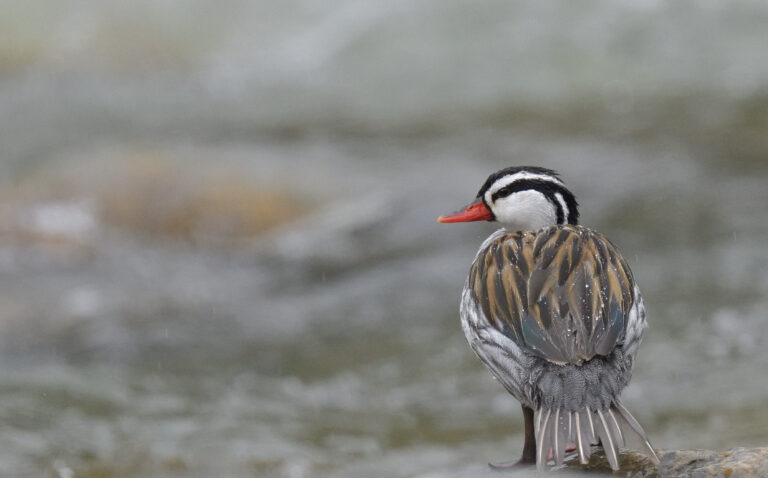
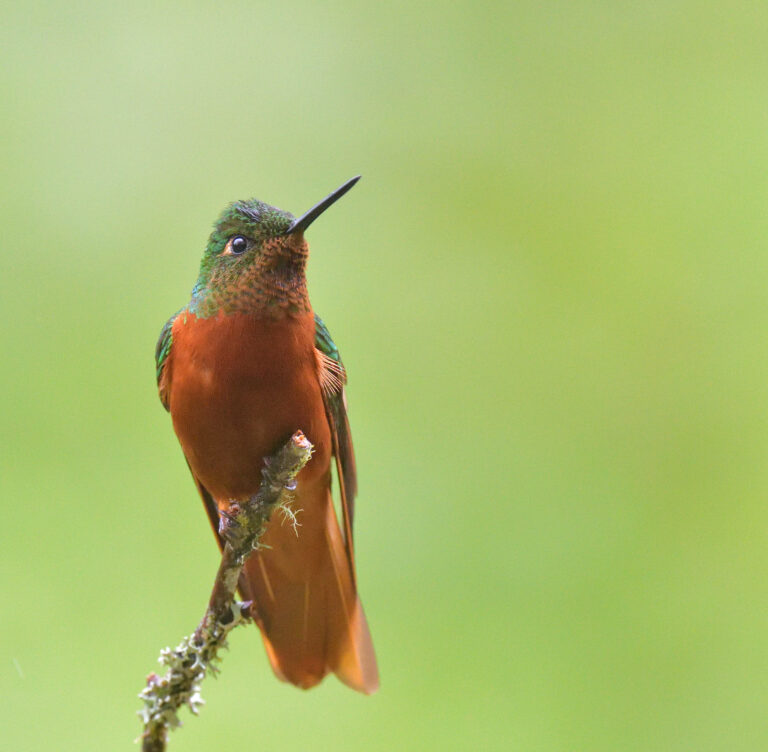
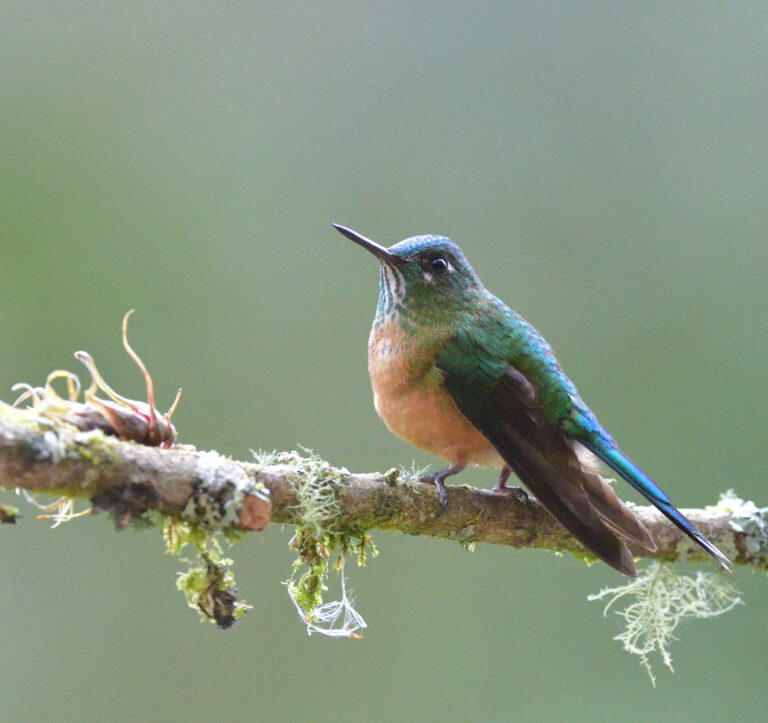
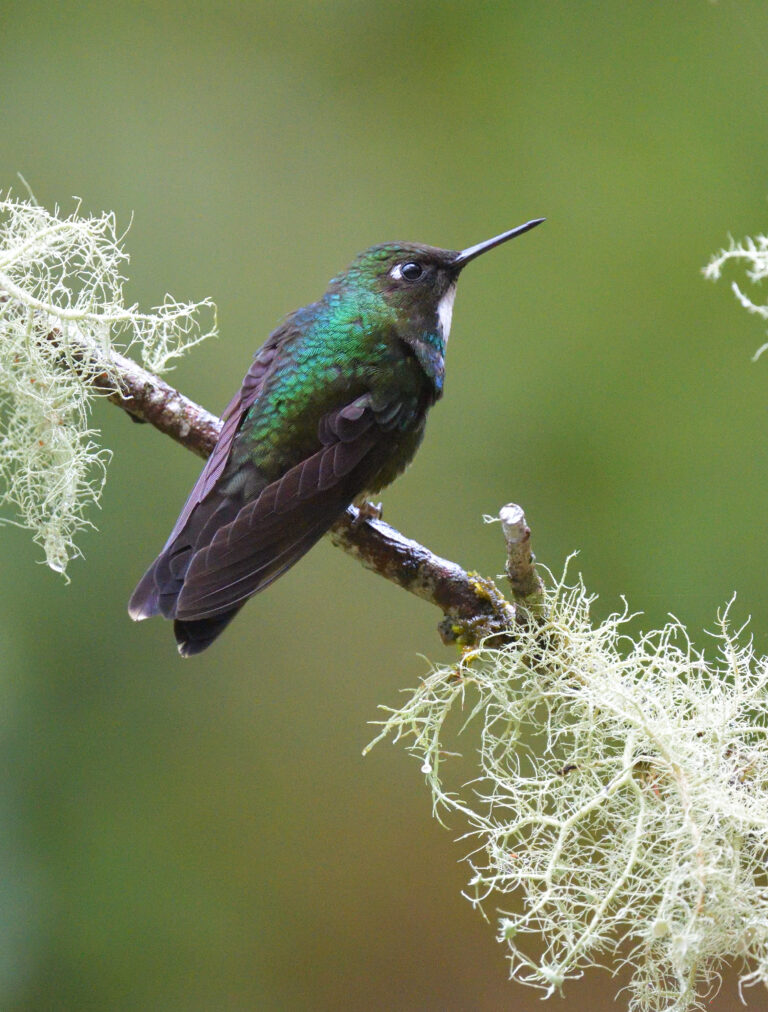
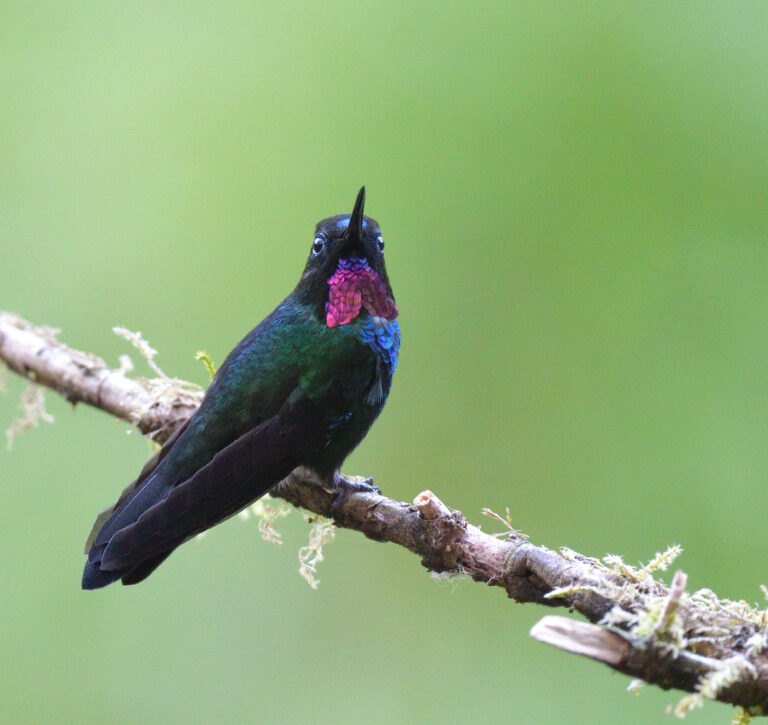
After breakfast this morning we have an appointment with the resident Chestnut-crowned Antpitta, which arrives for its breakfast of worms served by the lodge caretaker, every day at 7am! Described as “a potato on stilts”, the dumpy yet leggy bird arrives bang on time to gobble up its daily treat, completely unperturbed by its audience. Moving on to another of the lodge trails, we spot Slaty-backed Chat Tyrant, while the sound of blown raspberries alerts us to the presence of a tiny Rufous-crowned Tody Flycatcher, which shows really well at very close range.
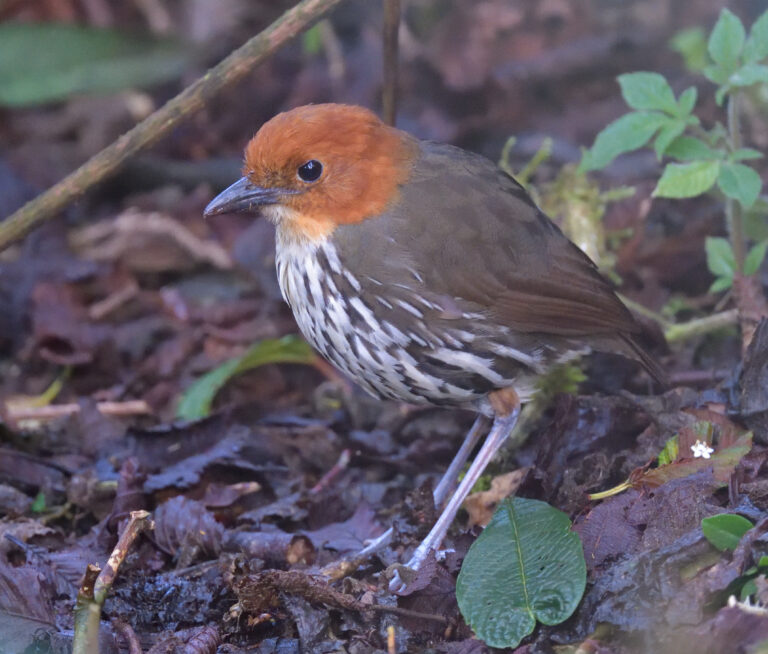
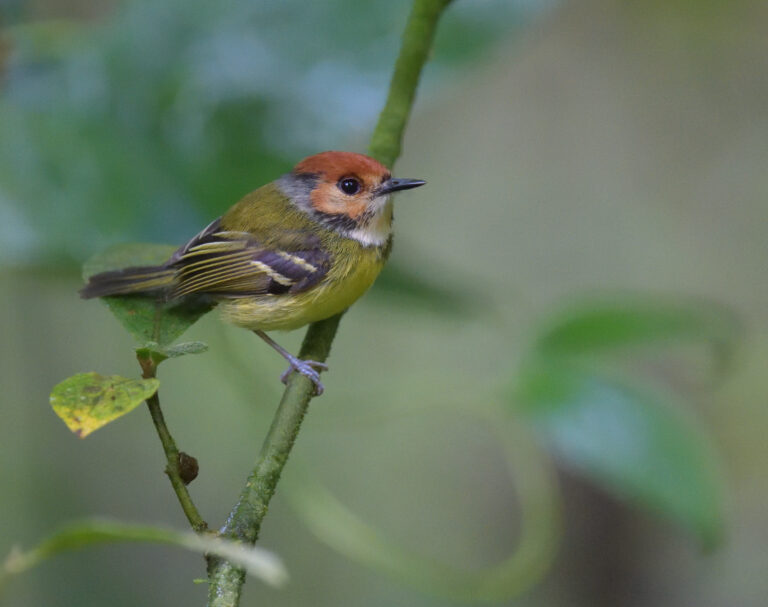
Returning to the Papallacta Pass, the Polylepis scrub produces Hooded Siskin, before we follow a rough track up through the sparse Paramo vegetation to some 13000 feet in Cayambe-Coca National Park, where new birds include, in order of appearance, Carunculated Caracara, Paramo Ground Tyrant, Andean Tit Spinetail, Chestnut-winged Cinclodes, Grass Wren, Plumbeous Sierra Finch, Streak-backed and Many-striped Canasteros, a tailless White-chinned Thistletail and an Andean Teal.
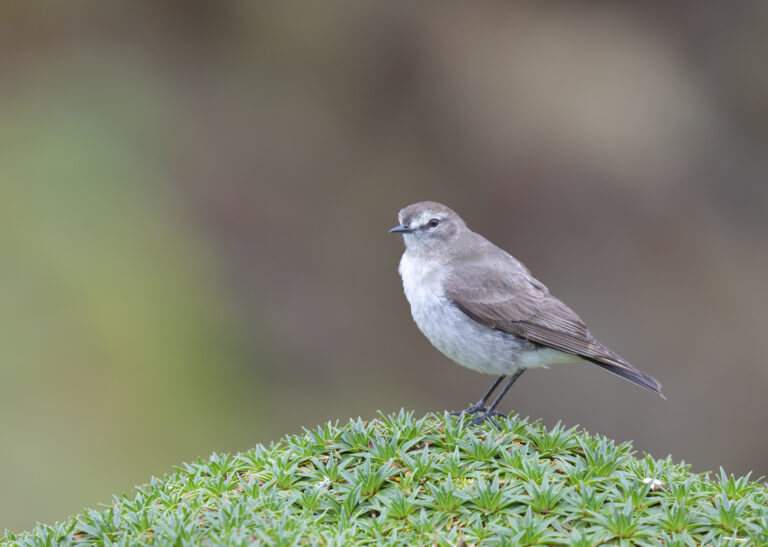
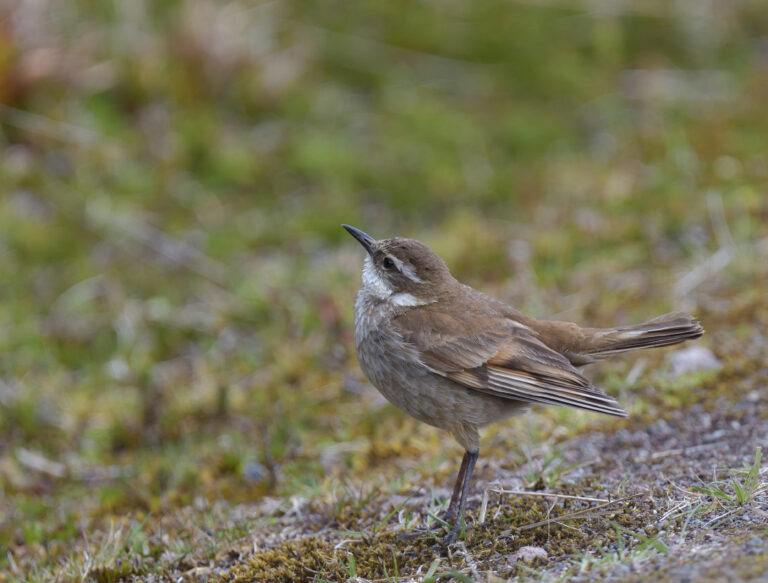
After lunch back at the lodge, we visit a different part of the national park, amid high steep valley slopes clad in dense cloud forest, with sparser Elfin forest near the tree line, where the damp misty conditions are far from ideal, but we still manage to find new birds like Pale-naped Brush Finch, White-throated Tyrannulet, Buff-winged Starfrontlet, Cinereous Conebill, Shining Sunbeam and a very confiding female Masked Trogon. We also bump into a mixed flock including Pearled Treerunner, Rufous Wren, Glossy Flowerpiercer, Blue-backed Conebill, Black-backed Bush Tanager, the stunning Golden-crowned Tanager and our main target, the scarce Masked Mountain Tanager, so not a bad list at all for a misty afternoon up in the clouds. After dinner, we retire to our rooms for a second night with complimentary hot water bottles!
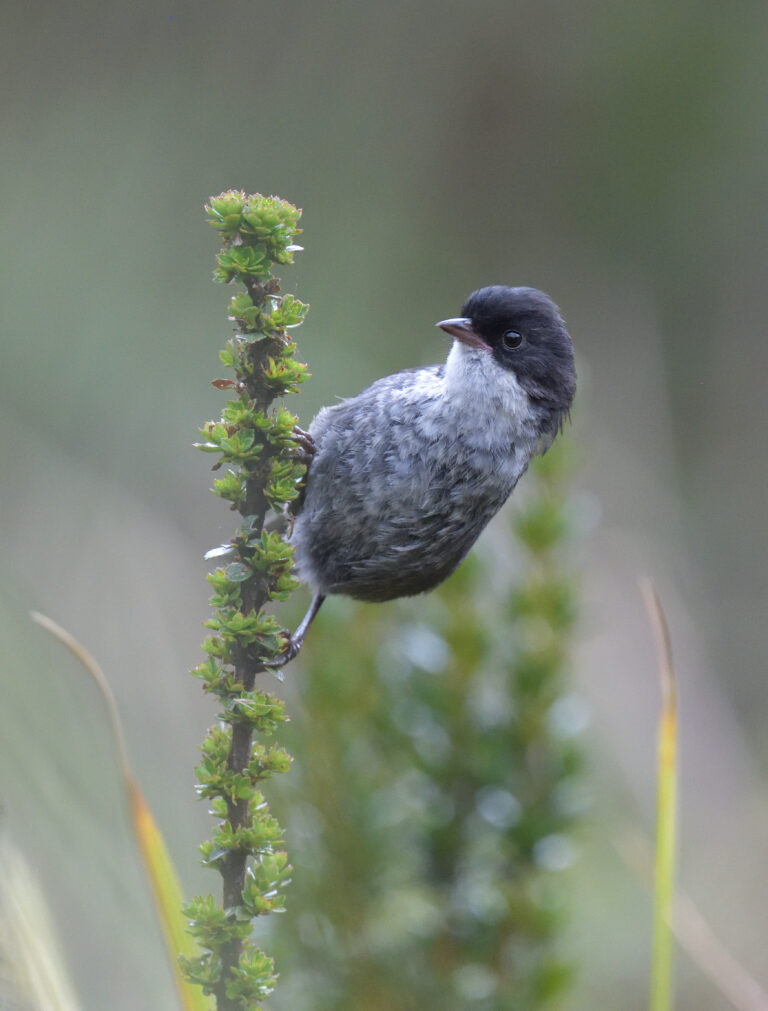
This morning we begin at 6.15am with a pre-breakfast vigil from a screen next to the lodge where the layout shows how much effort Guango has made to attract birds within a photogenic setting, thanks to the many moss-encrusted branches set up for a variety of local birds such as Turquoise and Inca Jays, Long-tailed Sylph, Rufous Wren, Masked Flowerpiercer, Canada Warbler, Black-eared Hemispingus, Blue-and-black Tanager, Grey-browed and Chestnut-capped Brush Finches and an Andean Guan, posing as if glued to one of the branches!
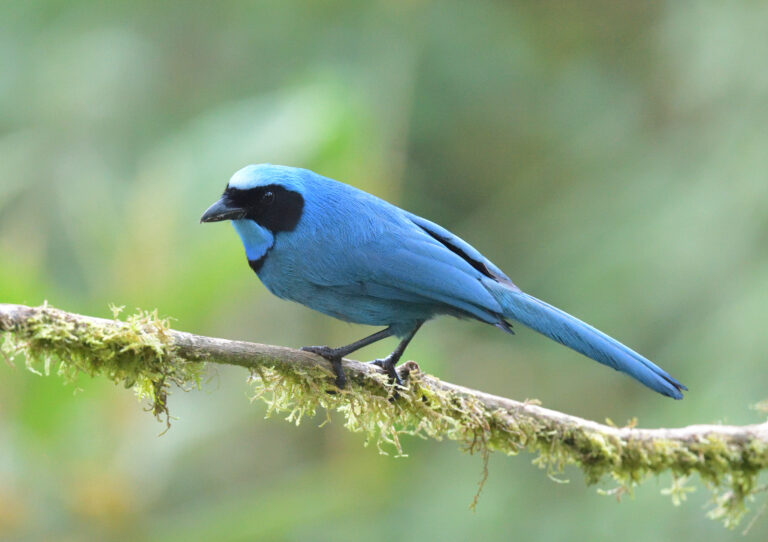
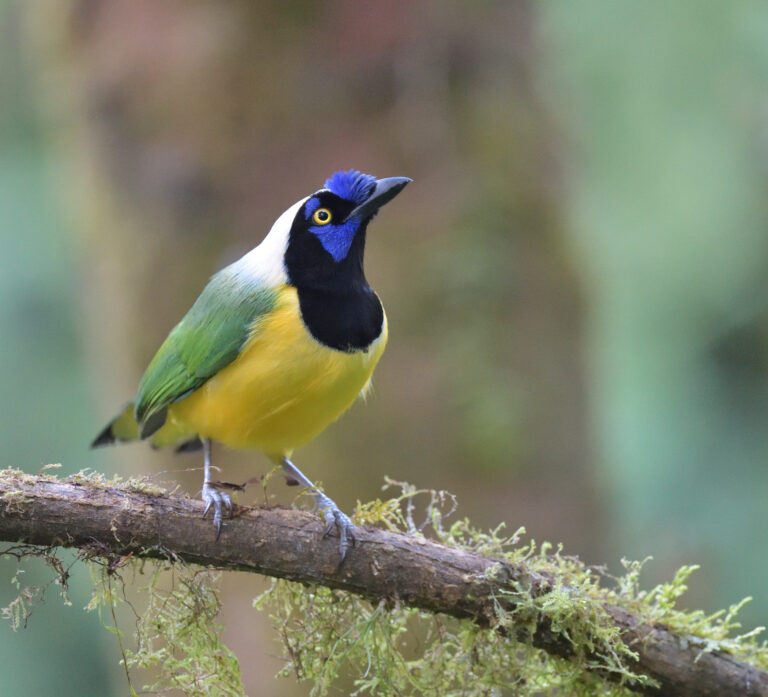
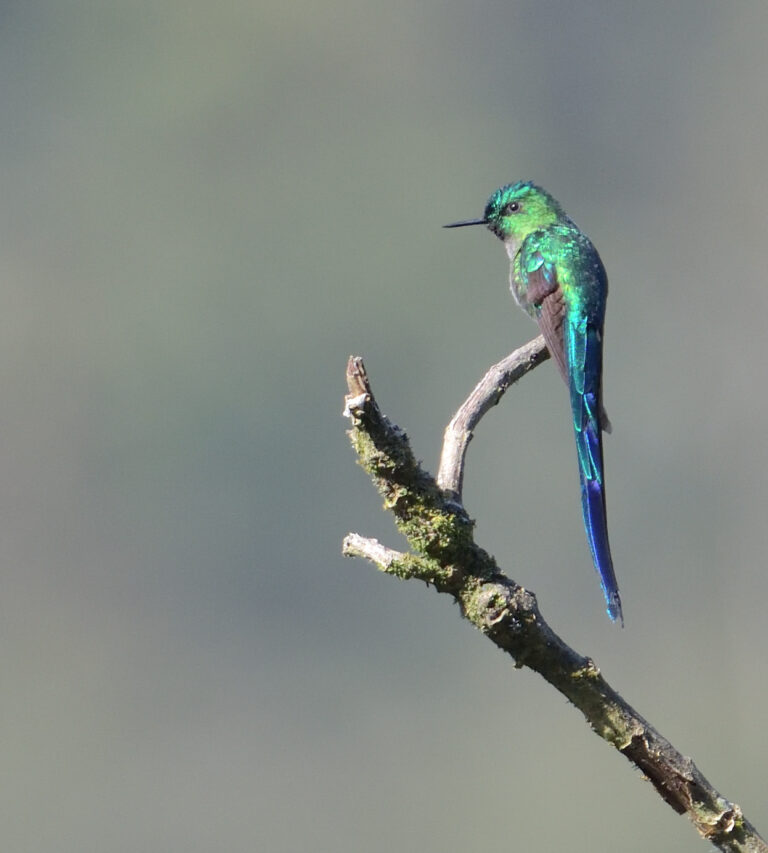
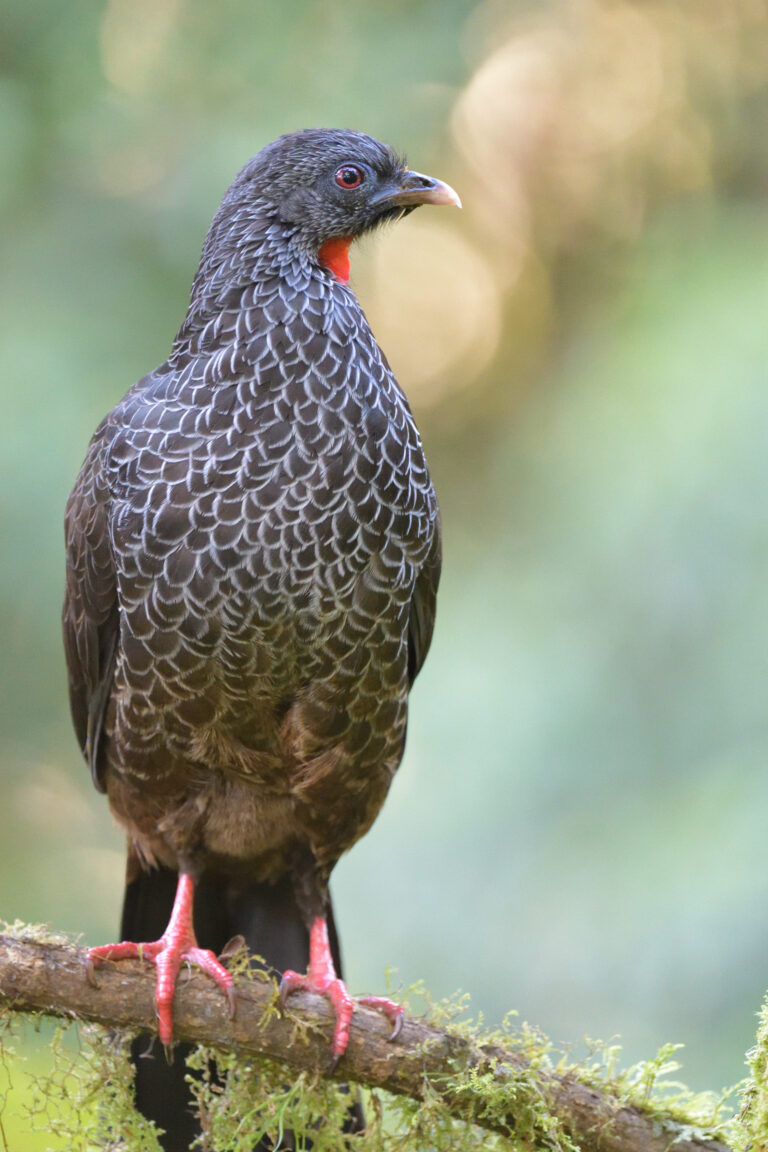
After breakfast, it’s downhill all the way on a winding road down the eastern Andean slope, with spectacular views of the snow-clad Antisana volcano looming over the vertiginous slopes cloaked in lush green cloud forest. Once the terrain levels out and the forest gives way to pastures, new birds include Cattle Egret, Southern Lapwing, Blue-and-white Swallow, Tropical Kingbird, Magpie Tanager, Smooth-billed Ani, Yellow-browed Sparrow and Red-breasted Blackbird, en route to El Concierto de las Aves, a wonderful rewilding project on the edge of Napo Galeras National Park. The proud eco-friendly owner begins his guided tour with a superb male Andean Cock-of-the-Rock (the bright orange aequatorialis race), ‘on a plate’, sitting still on a branch just a few yards away from a plastic chair which the owner had placed for us to take turns to view this flamboyant bird in comfort! A little further on, feeders give fabulously close views of new birds like Green-backed Hillstar, Violet-fronted Brilliant, Chestnut-bellied Thrush, Red-headed Barbet and Orange-bellied Euphonia, while the adjacent flowering shrubs attract Tawny-bellied Hermit, Speckled Hummingbird and Peruvian Racket-tail. Following the clear flowing stream, home to Torrent Tyrannulet, we spot Southern Rough-winged Swallow, Slate-throated Redstart, Montane Woodcreeper, Long-tailed Tapaculo, and Swainson’s Thrush all the way from North America.
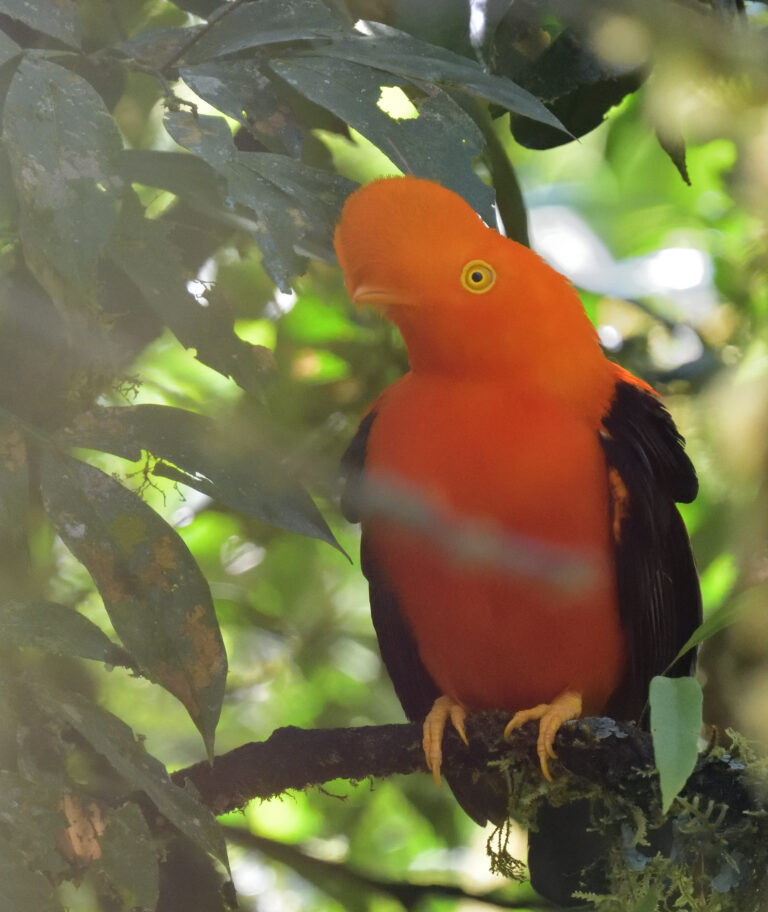
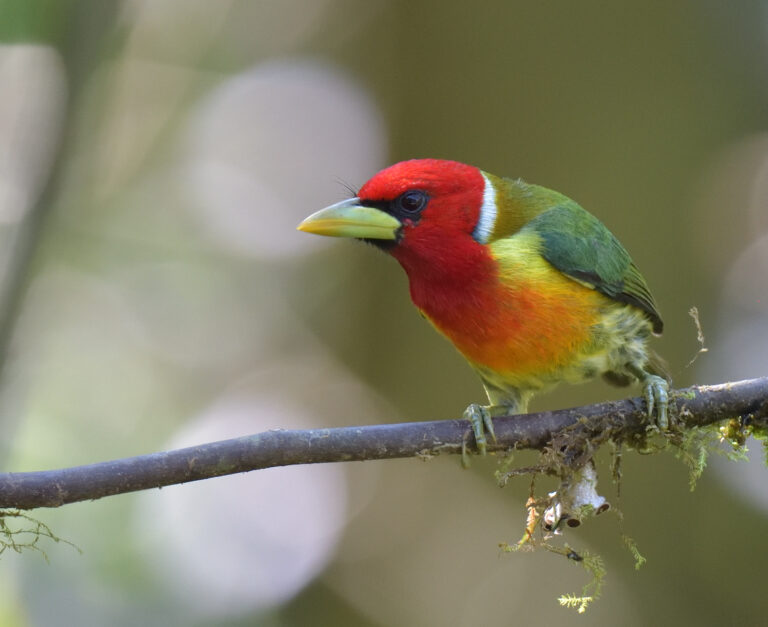
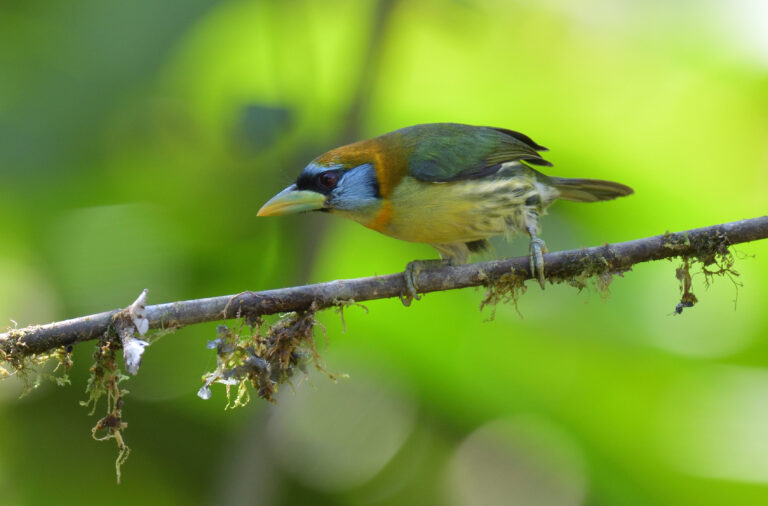
Moving on, we arrive at the very plush San Isidro Lodge in time for a sumptuous lunch, with trout for the main course. This afternoon, we explore the local area, finding birds like Lemon-browed Flycatcher, Saffron-crowned Tanager, Brown-capped Vireo, Black-crested Warbler, Scarlet-rumped Cacique and Scaley-naped Amazon, as well as a slender twenty inch long black and red banded Andean Flame Snake.

This evening, the gourmet-style dinner is interrupted by the appearance of the enigmatic ‘San Isidro Owl’, sitting on a stump just ten yards from the terrace at eye level! The bird is a mystery because it is intermediate in appearance between the Black-banded and Black-and-white Owls, but occurs at a higher elevation than either of these owls and has not yet been scientifically classified!
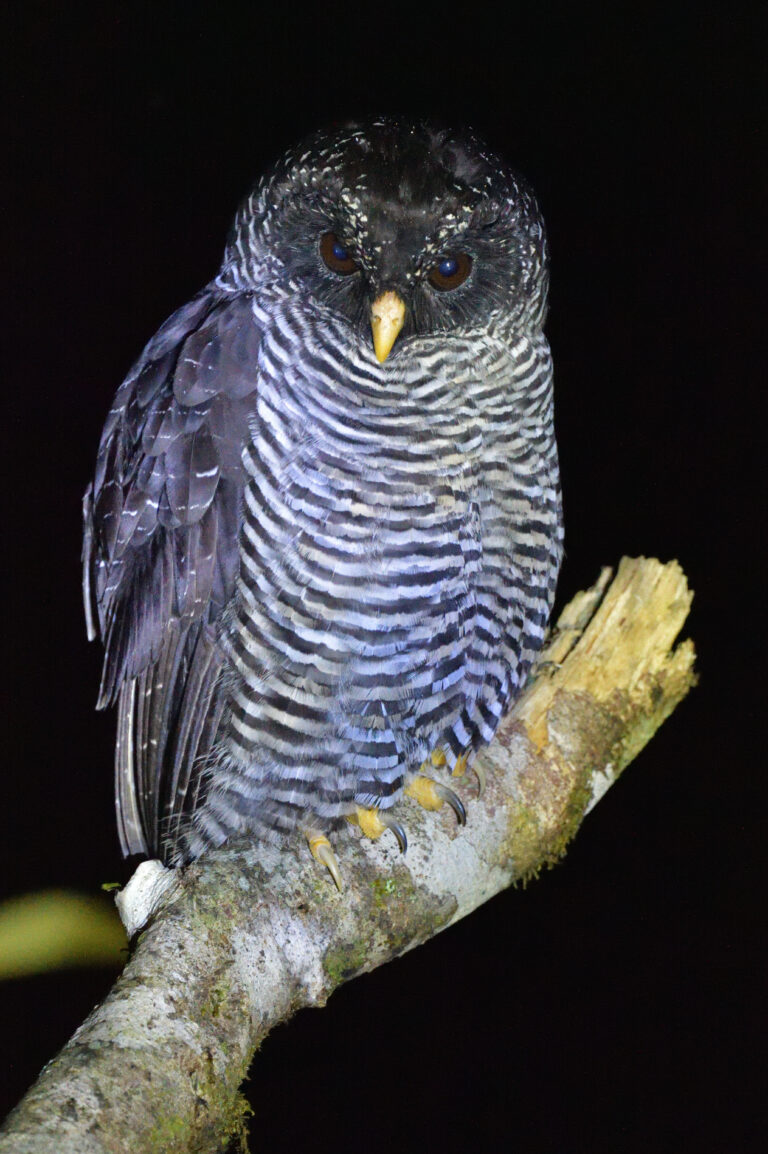
This morning we start with a cup of tea on the terrace at 6am, while watching a dazzling variety of birds at close range, including ‘hummers’ like Chestnut-breasted Coronet, Bronzy Inca and Fawn-breasted Brilliant, as well as larger birds like Masked Trogon, Inca Jay, Scarlet-rumped Cacique and Strong-billed Woodcreeper, all virtually at arm’s length! A mesmerising hour flies by as birds just keep coming, including Smoke-coloured Pewee, Pale-edged and Cinnamon Flycatchers, Swainson’s Thrush, Sparkling Violetear, Montane Woodcreeper, Canada and Blackburnian Warblers, Slate-throated Redstart, Black-billed Peppershrike, Azara’s Spinetail, Common Chlorospingus and Summer Tanager, as well as a Black Agouti (a large rodent). What an incredible show.
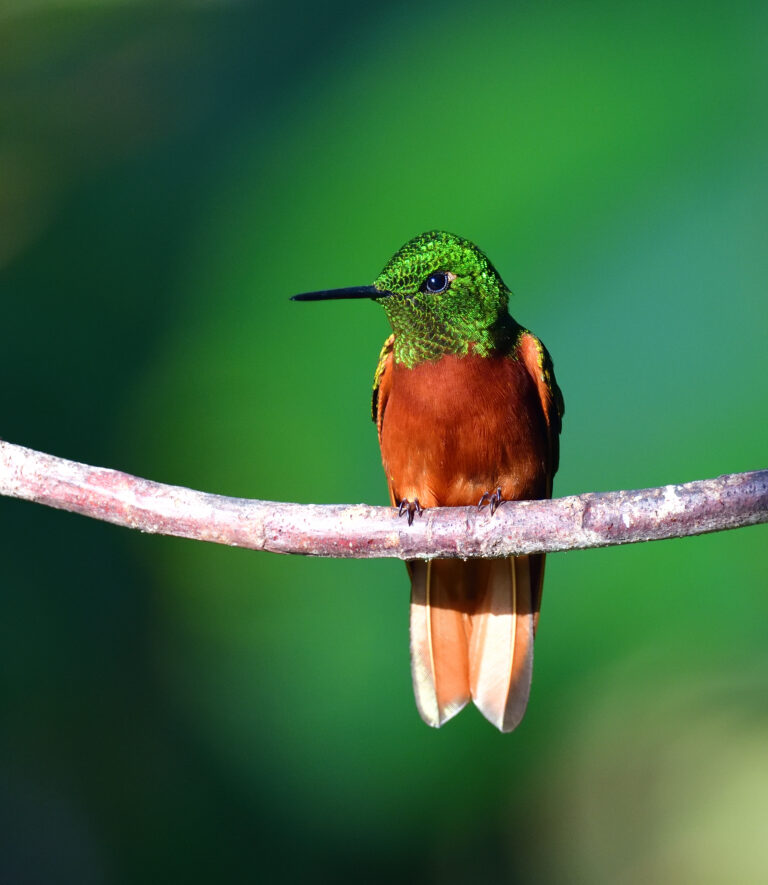
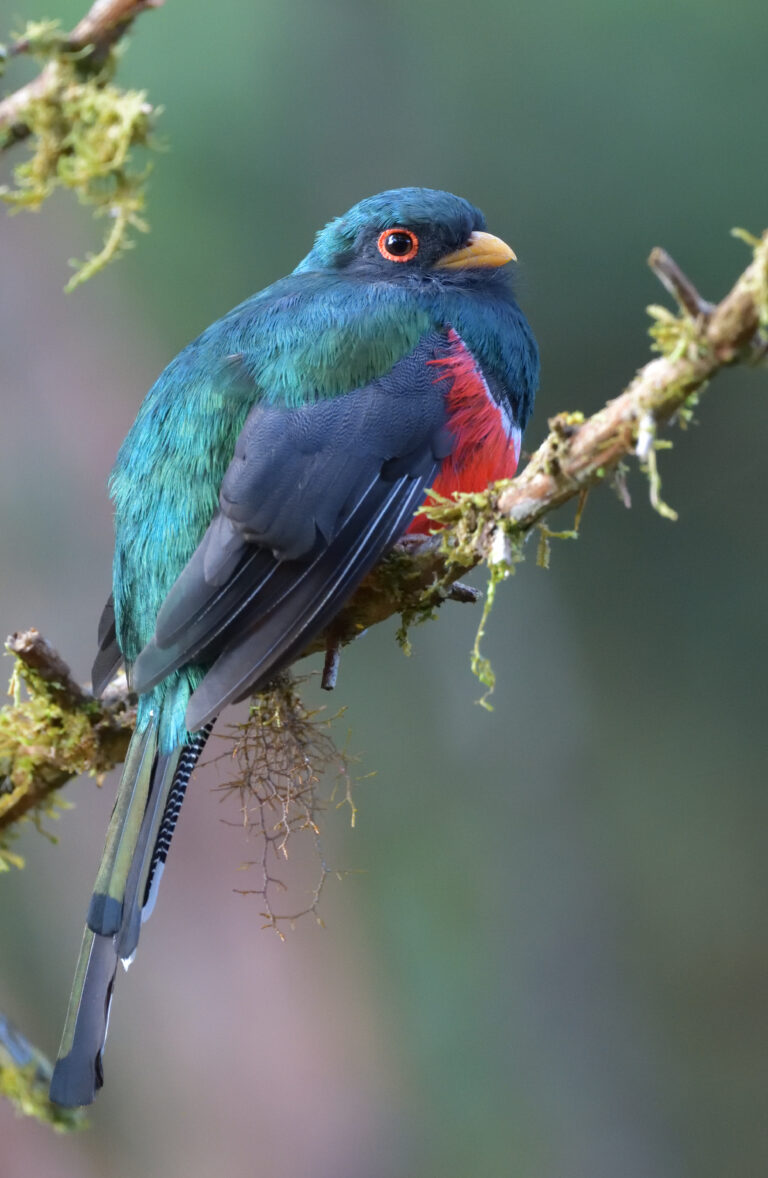
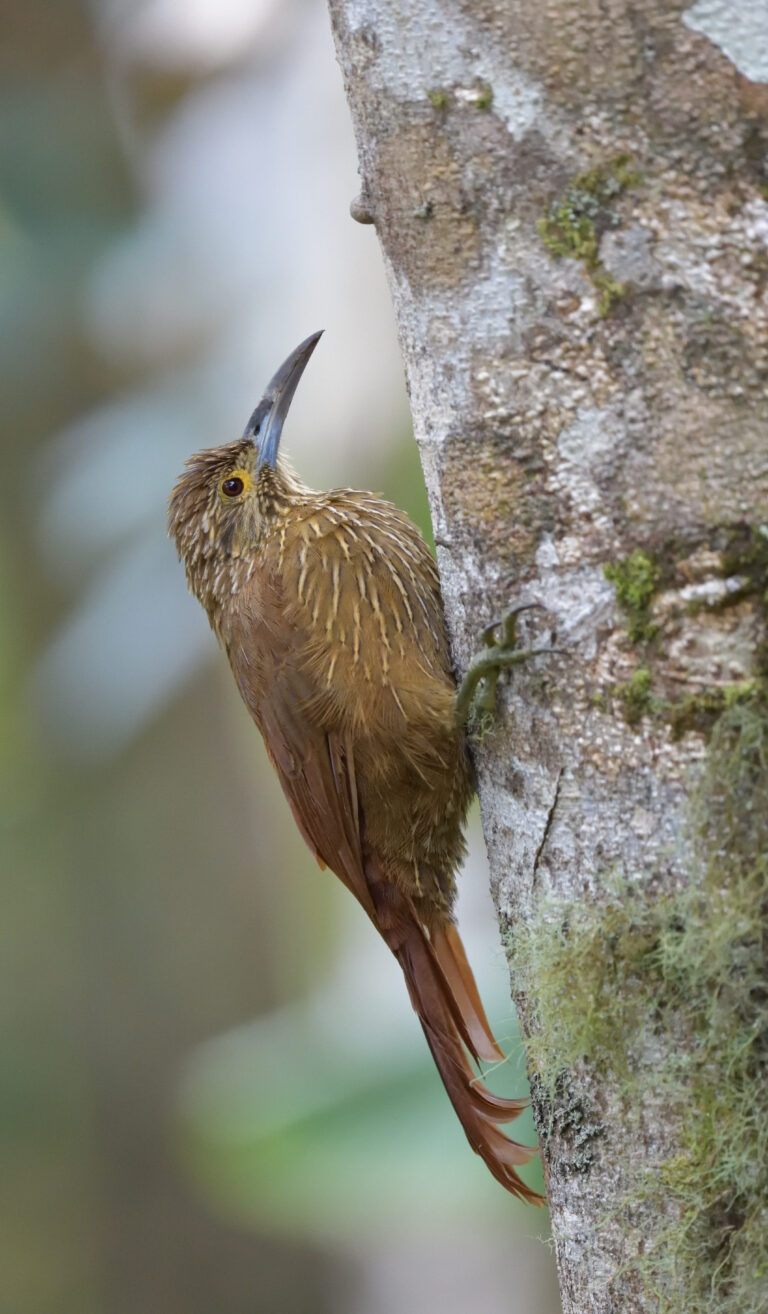
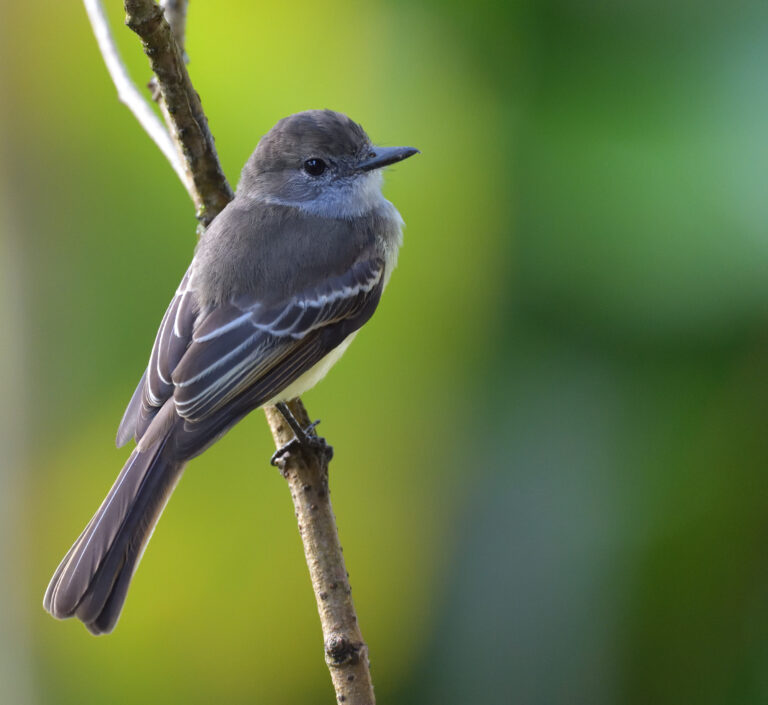
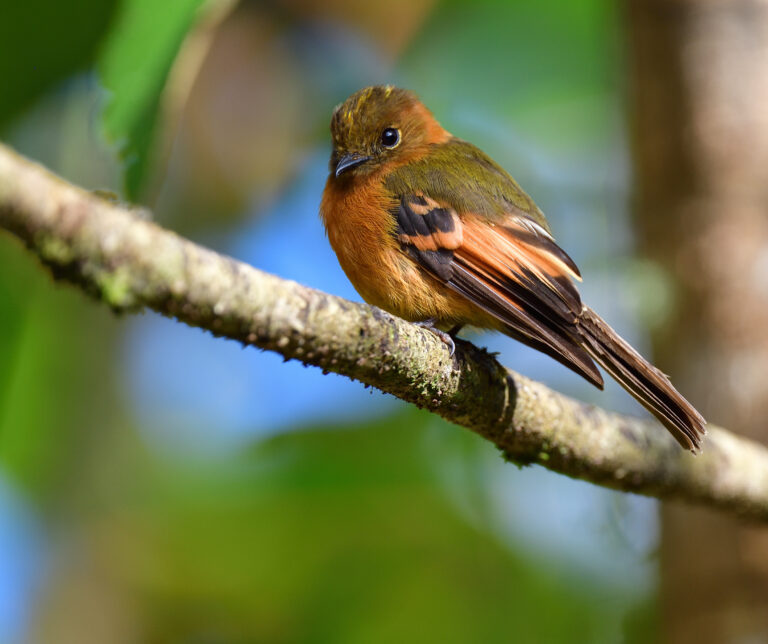
By 7.30am it’s time for another antpitta ‘show’ and so we follow the lodge caretaker into the nearby woods, where he sprinkles worms and whistles up a White-bellied Antpitta to within five yards of the small ‘crowd’ gathered to see the performance!
After a later than normal breakfast, a short drive takes us to a misty ridge, where we follow the Sendero Jumandy which steadily descends through a thick forest of tall trees, laden with mosses and red flowering epiphytes, with a dense understorey of bamboo. Despite the misty start we find Green-and-black Fruiteater, Grass-green Tanager, Lacrimose Mountain Tanager, Rufous-breasted Flycatcher and, best of all, Black-billed Mountain Toucan, a lifer even for our local guide! We also find a giant snail, easily five inches long!
Once back at the lodge, after a well-earned afternoon tea, another exploration of the dirt road outside the lodge produces Golden-headed Quetzal, Flame-faced Tanager, White-tailed Tyrannulet, Speckle-faced Parrot and Yellow-vented Woodpecker.
During dinner, this evening, the ‘mystery owl’ makes another appearance right outside the terrace, where we saw so much first thing this morning.
This morning we leave San Isidro, heading further down the eastern Andean slope, with birding stops along the way. The first stop produces a delightful assortment of tanagers; Yellow-throated, Scarlet, Beryl-spangled, Flame-faced, Black-capped and Orange-eared, plus Blue-winged Mountain Tanager, Andean Solitaire, Southern Emerald Toucanet, Streak-necked Flycatcher and Deep-blue Flowerpiercer; wow!
Moving on to a cliff of orange and grey rock, we find the similarly coloured Cliff Flycatcher, as well as Green-backed Hillstar, Blue-grey and Swallow Tanagers, Olivaceous Siskin and Bronze-green Euphonia. At the next stop we visit a ‘hummingbird garden’ where we add Golden-tailed Sapphire, Fork-tailed Woodnymph and Many-spotted Hummingbird to the growing list.
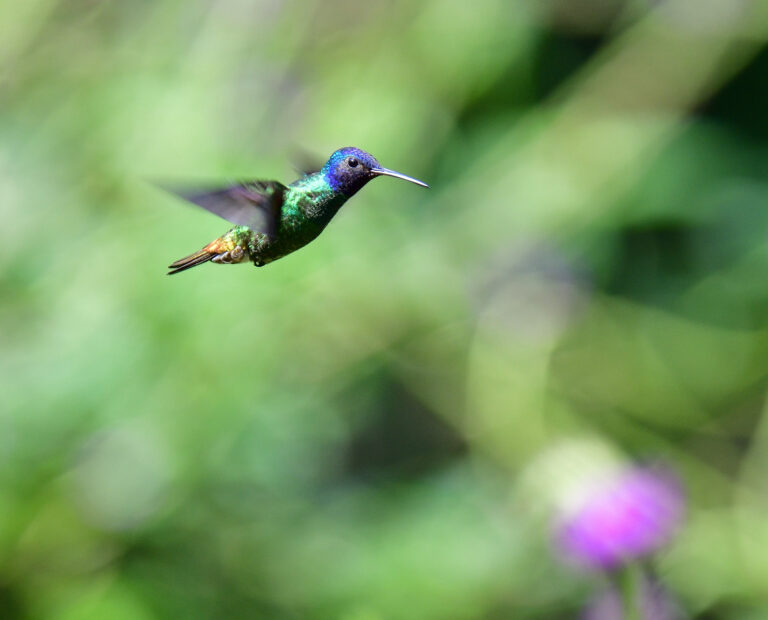
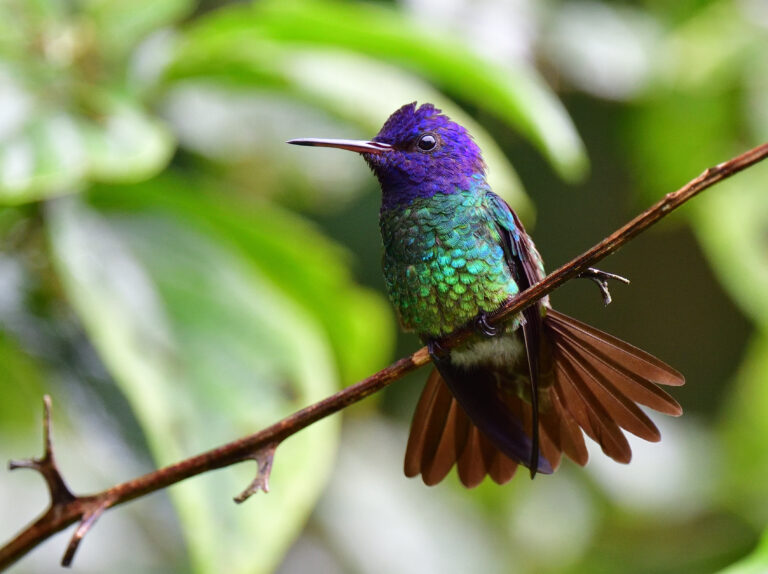
Arriving at the Wild Sumaco Lodge, the sugar feeders are a hive of activity, where the feeding frenzy includes a restless selection of yet more new ‘hummers’ like Violet-headed Hummingbird, Wire-crested Thorntail, Black-throated Brilliant, Brown Violetear and the stupendous Gould’s Jewelfront. We also spot Blackish Antbird before sitting down for lunch which is interrupted by the appearance of Black-mantled Tamarins in a tree outside the dining room and a Grey-fronted Dove hurtling in through an open window before bouncing off three walls and ending up behind a sideboard!
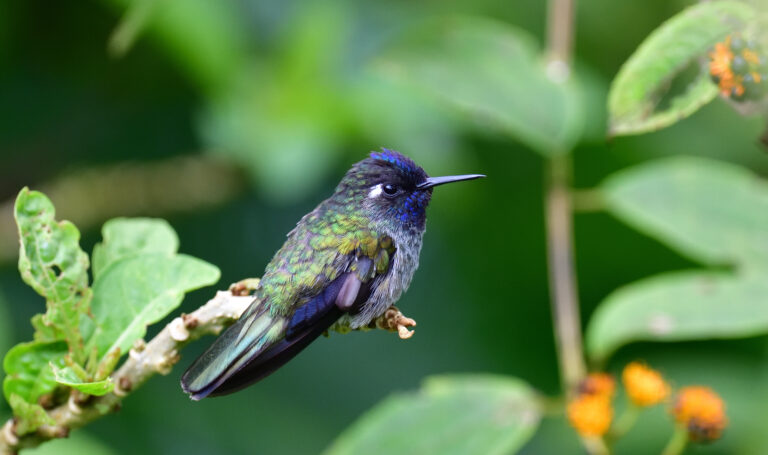
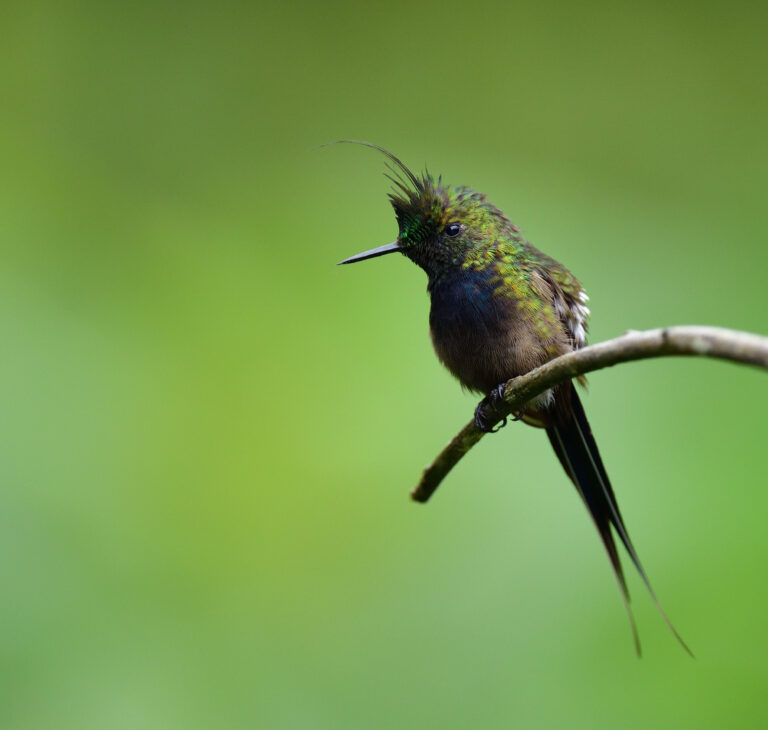
This afternoon we begin with a Squirrel Cuckoo, a lovely Ornate Flycatcher and a swarm of White-collared Swifts overhead. Strolling further from the lodge, we find a tiny Scale-crested Pygmy Tyrant, plus Buff-fronted Foliage Gleaner and Golden-faced Tyrannulet. Along the Coopman’s Trail, we spot a smart male Blue-rumped Manakin deep in the foliage and two Swallow-tailed Kites gliding gracefully over the tree canopy, on the way to an antpitta feeding station where a scattering of worms attracts first an Ochre-breasted Antpitta, the size of a Robin, and then a considerably larger Plain-backed Antpitta, making excellent views of five different antpittas so far, with a bonus Crimson-crested Woodpecker hammering at a tree trunk high above the terrestrial antpittas. Heading back along the trail, an impressive Yellow-throated Toucan is another good find.
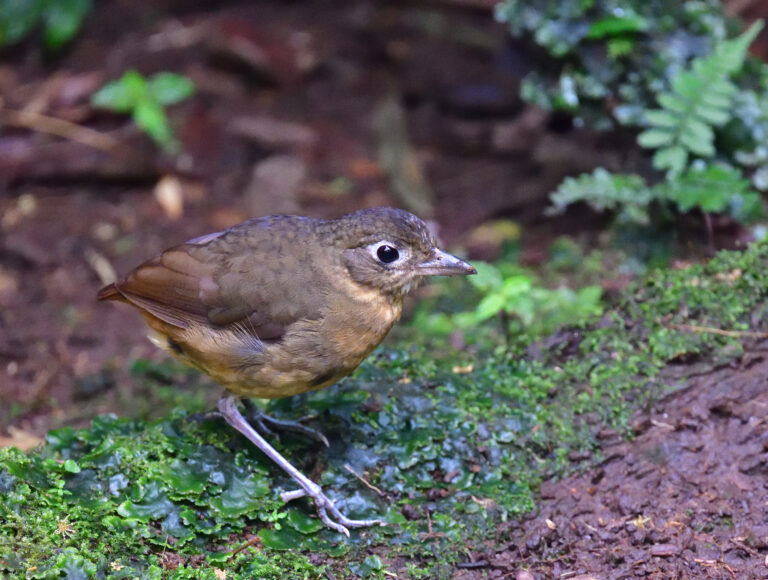
By late afternoon it’s raining, so we take shelter under an open sided greenhouse, and watch a veritable bird fest in the small holding as a constant stream of birds show up such as White-eyed Parakeet, Collared and Green-backed Trogons, Golden-olive Woodpecker, Olive-backed Woodcreeper, Sreaked Xenops, Western Wood-Pewee, Slaty-capped and Bran-coloured Flycatchers, House Wren, Red-eyed Vireo, Black-billed Thrush, Blackburnian, Cerulean and Canada Warblers, Tropical Parula, Bananaquit, Spotted, Golden, Bay-headed, Silver-beaked and White-lined Tanagers, Chestnut-bellied Seedeater, Yellow-browed Sparrow, Yellow-rumped Cacique and the tiny Lafresnaye’s Piculet! Not bad for a wet afternoon.
After breakfast this morning, a screen adjacent to the lodge produces male and female Black-faced Antbirds and Western Fire-eye, and a little further along the trail we find a female Plain Antvireo, a motionless Black-streaked Puffbird and a very mobile Wing-banded Wren. After a very short drive we follow another trail through the forest, finding Rufous-winged Antwren, Ecuadorian Piedtail and a male White-crowned Manakin along the way to a shelter overlooking an extensive forest protruding from patches of mist, where we scope a female Gilded Barbet in the top of a distant Cecropia tree. Suddenly, we realise why it’s called rainforest as the heavens open, releasing a torrential downpour. Fortunately, we are already under the cover of the shelter but after sitting it out for a while, there seems no end in sight and so we make a run for it back to the vehicle. After drying out with a cup of tea back at the lodge, the rain eases and so we try again around the lodge, finding Buff-fronted Foliage Gleaner, Yellow-olive and Olive-striped Flycatchers, Rufous-naped Greenlet, Olivaceous Siskin and Golden-collared Honeycreeper.
After lunch a new forest trail leads to sugar feeders where new ‘hummers’ include Green Hermit and Napo Sabrewing. Other sightings along the trail include Plumbeous Pigeon, Olive-chested Flycatcher and a male Red-headed Barbet. Back on the road, sightings include Roadside Hawk (where else?), Rufous-tailed Foliage Gleaner, Plain Xenops, Yellow-breasted Antwren, Ecuadorian Tyrannulet, Squirrel Cuckoo, Coppery-chested Jacamar, Olivaceous Greenlet, Silver-beaked and Palm Tanagers, Chestnut-fronted Macaw, a pair of Gilded Barbets, a pair of impressive Military Macaws and a trio of Yellow-tufted Woodpeckers. After a lot of searching, we also finally ‘nail’ the vociferous Lined Antshrike.
As the light begins to fade, we follow a narrow trail into the forest for a spot of ‘owling’. Once in position, around 6.30pm, the ‘night shift’ takes over. An orchestra of stridulating insects comes to life and fairy-like fireflies start to dance. By now, one can barely make out individual branches within the dense dark forest and yet suddenly Juan Carlos points his torch towards a twig, ten yards away, with a Rufescent Screech Owl sitting peacefully on it and looking down at the ground with its large dark eyes! Within seconds, Juan Carlos hurries us back along the trail and points his torch up to another branch, bearing a tiny Foothill Screech Owl, starring into the forest with sharp yellow eyes! How JC knew the owls were there is a mystery, but what an amazing experience.
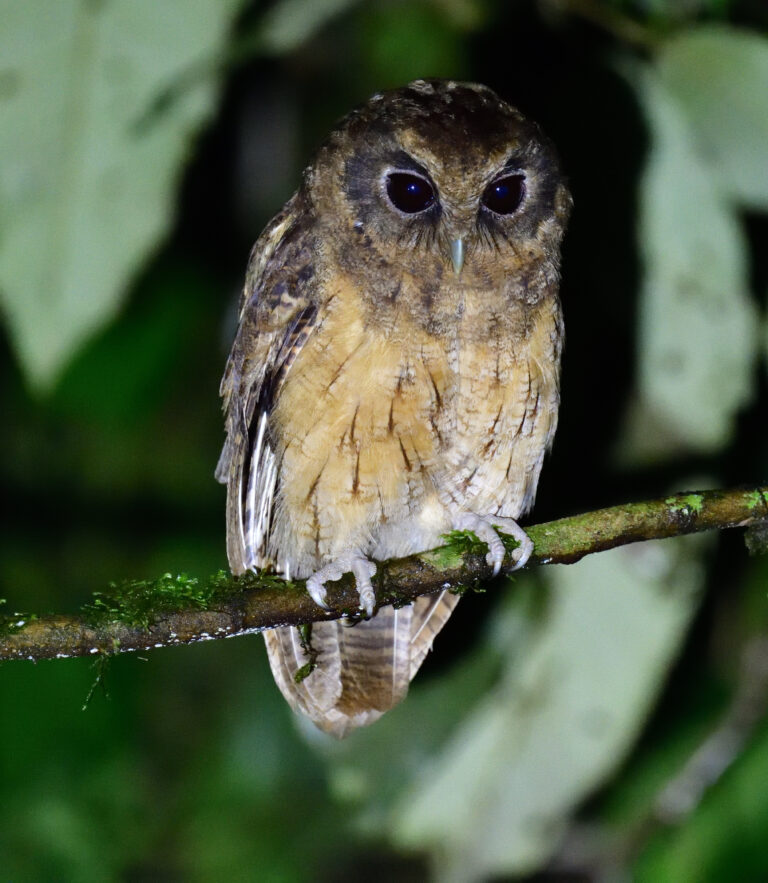
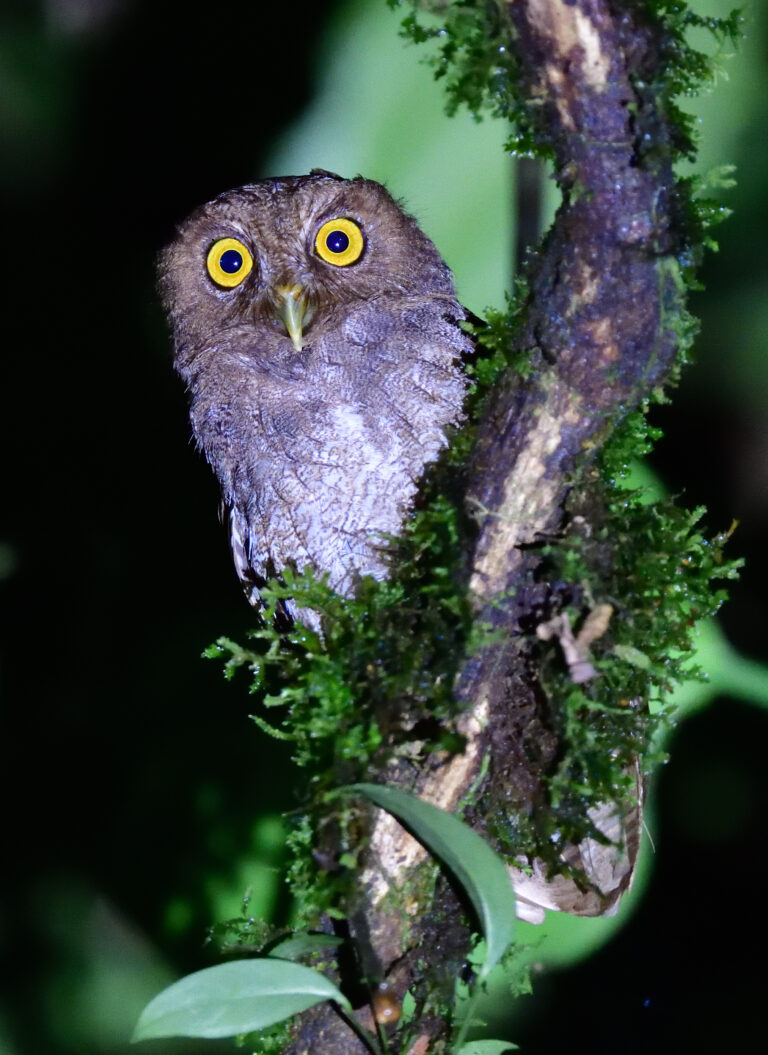
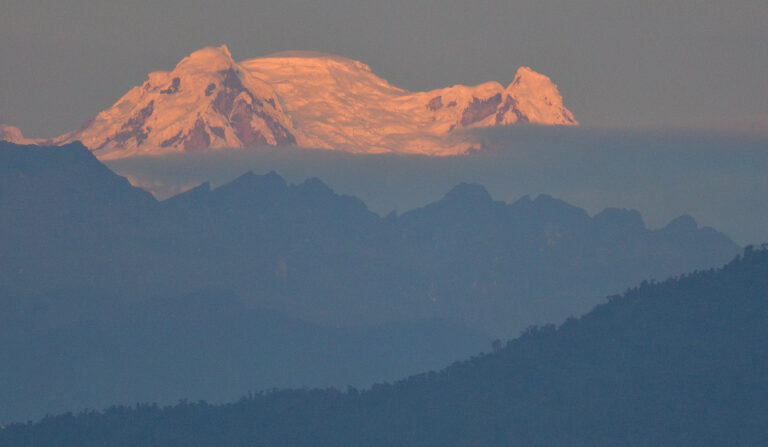
This morning we awake to a clear sky with a bright full moon and the snow-capped Antisana volcano standing proud of the verdant forested slopes in the middle distance. Where else can one see a snow-capped volcano above tropical rainforest? We begin with a last exploration of the Wild Sumaco area, beginning with an even closer encounter with those noisy Military Macaws, as well as the Chestnut-fronted Macaw, followed by the elusive White-tailed Tapaculo and the Grey-tailed Piha with its piercing call.
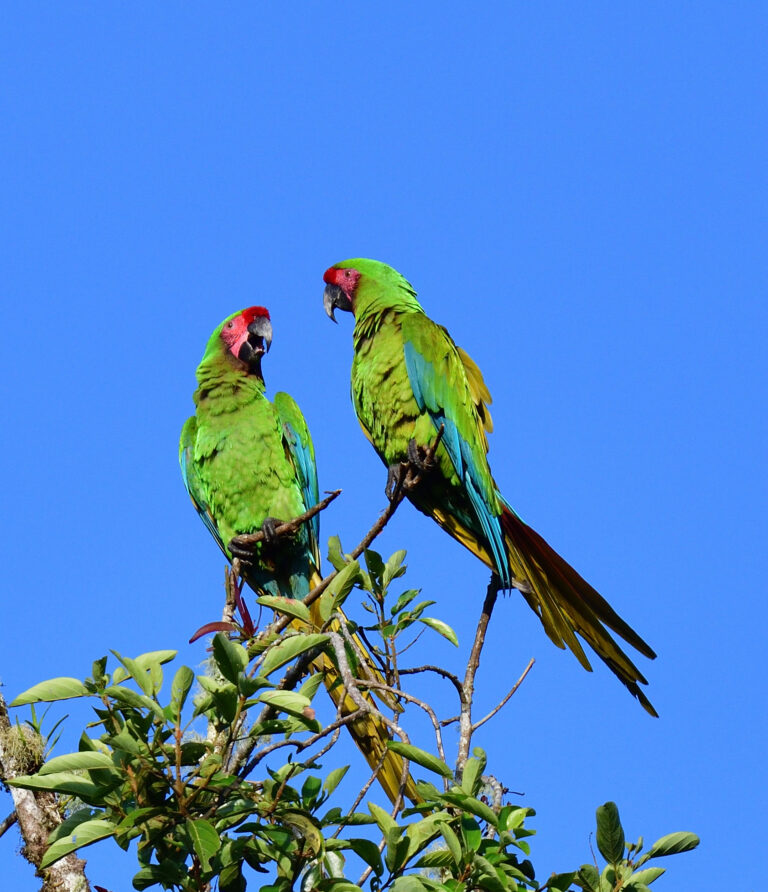
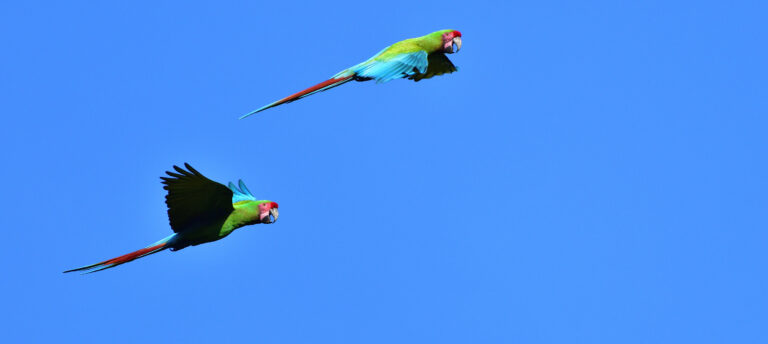
At 8.50am we have to leave the area and head further east down the final flight of Andean foothills to Francisco de Orellana, aka Coca town, ‘gateway’ to the Ecuadorian part of Amazonia. Our final destination is Sacha Lodge and getting there is an adventure, beginning with a 90 minute boat ride down the mighty Napo River, spotting Great Egret, Cocoi Heron, Black Caracara and White-winged Swallow on the journey downriver. Arriving at the welcome sign to Sacha Lodge, it’s a half hour walk from the river to a small creek where we board a small boat, paddled by Shanshu, one of the lodge guides, spotting Amazonian Motmot, Anhinga, Pale-vented Pigeon, Grey-breasted Martin, Lesser Kiskadee, Boat-billed Flycatcher and the amazingly vivid Masked Crimson Tanager along the way. After another half hour the creek opens out into a sizeable lake (Pilchicocha) with the lodge dining terrace overlooking the lake on the opposite side, a great place for a cool welcome drink and a lovely buffet lunch.
After settling in at our new home, we set off on a boat ride across the lake and into one of several creeks which meander through the dense flooded forest, known locally as Várzea. Along the creek we find Plain-brown and Straight-billed Woodcreepers, male and female Dot-backed Antbirds, Chestnut Woodpecker, White-chinned Jacamar, and finally, Tawny-bellied Screech Owl, on the very branch that Shanshu predicted it would show up on!
This morning we follow a short trail to Sacha’s canopy walkway, an engineering masterpiece, consisting of two towers accessed by 225 steps and connected by a 984 foot long wobbly walkway. The six minute ascent takes one to a viewing platform midway along the walkway, 121 feet above the ground, and even higher than the treetop canopy, providing a 360 degree panoramic vista across the forest and fabulous views of a mind-blowing variety of birds. Even up here, there are inch long Bullet Ants which must have climbed all the way up from the ground! Imagine that on a human scale! From the platform, a constant stream of birds shows up, at times so rapid it’s hard to keep pace with the action, so I may have missed a few. We begin at 6.20am with Plumbeous Kite, Paradise and Magpie Tanagers and a pair of Thrush-like Wrens, followed by Opal-rumped Tanagers and Bright-rumped Attila at 6.25, Black-crowned Tityra at 6.30, Palm Tanager singing from the adjacent walkway at 6.32, Speckled Chachalacas at 6.33, White-throated Toucan at 6.34, Spix’s Guan at 6.37, a male Plum-throated Cotinga at 6.41, Crimson-crested Woodpecker at 6.42, Turquoise Tanagers and a pair of Yellow-bellied Dacnises at 6.44, Pied Puffbird at 6.48, Lettered and Many-banded Aracaris at 6.50, White-lored Euphonia at 6.53, Blue-headed Parrots at 6.55, Orange-winged Parrot, Gilded Barbet and Piratic Flycatcher at 6.57, Lemon-throated Barbet at 7.02 and Red-eyed Vireo and Ringed Woodpecker at 7.10, making at least 25 species after an hour! Subsequent highlights include Blue-grey Tanagers at 7.22, Cream-coloured Woodpecker at 7.35, male Spangled Cotinga and Giant Cowbird at 7.40, Yellow-tufted Woodpeckers and Purple Honeycreeper at 7.45 and our fifth woodpecker, Scaley-breasted, at 7.55. The action continues; 7.57, Mr & Mrs Blue Dacnis, 8am, Mr Green Honeycreeper and a Yellow-crowned Tyrannulet, 8.05, Red Howler Monkey, 8.10, Grey Mourner and Short-crested Flycatcher. By now as the air warms up, raptors put in appearances like Greater Yellow-headed and Black Vultures, Black Caracara, Double-toothed and Slender-billed Kites plus Slate-coloured and Crane Hawks. Further sightings include White-necked Puffbird, Buff-throated Woodcreeper, Bare-necked Fruitcrows, Channel-billed Toucan, Grey-breasted Martin, Black-tailed Tityra, Moriche Oriole, Yellow-rumped Cacique, Dusky-headed Parakeet, Russet-backed Oropendola and Green-and-gold and Opal-crowned Tanagers, making well over 50 species from one viewpoint!
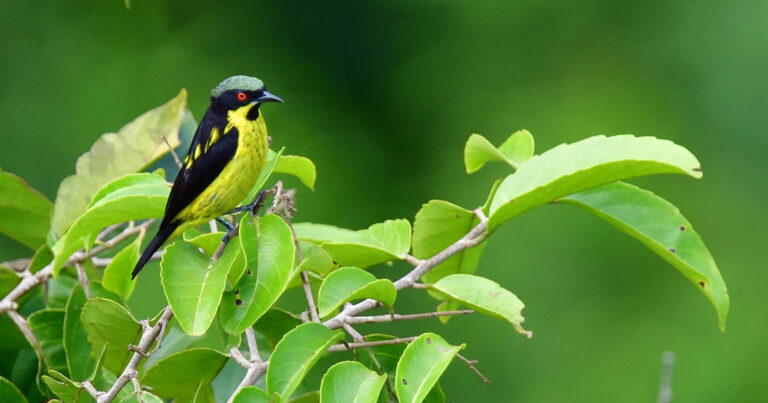
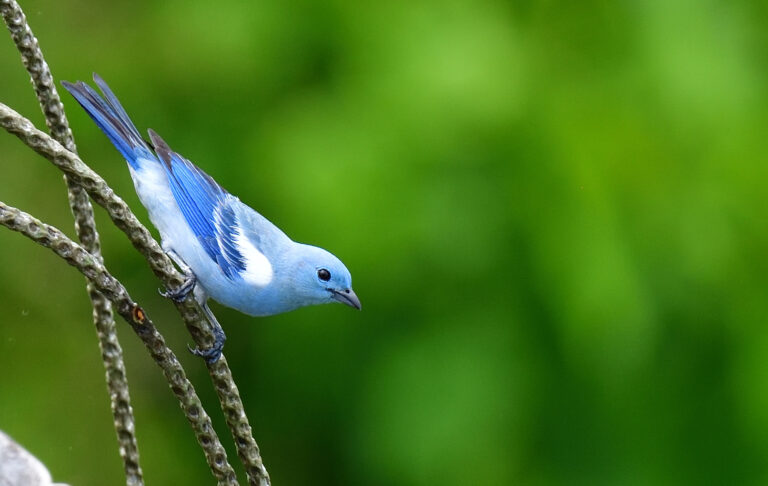
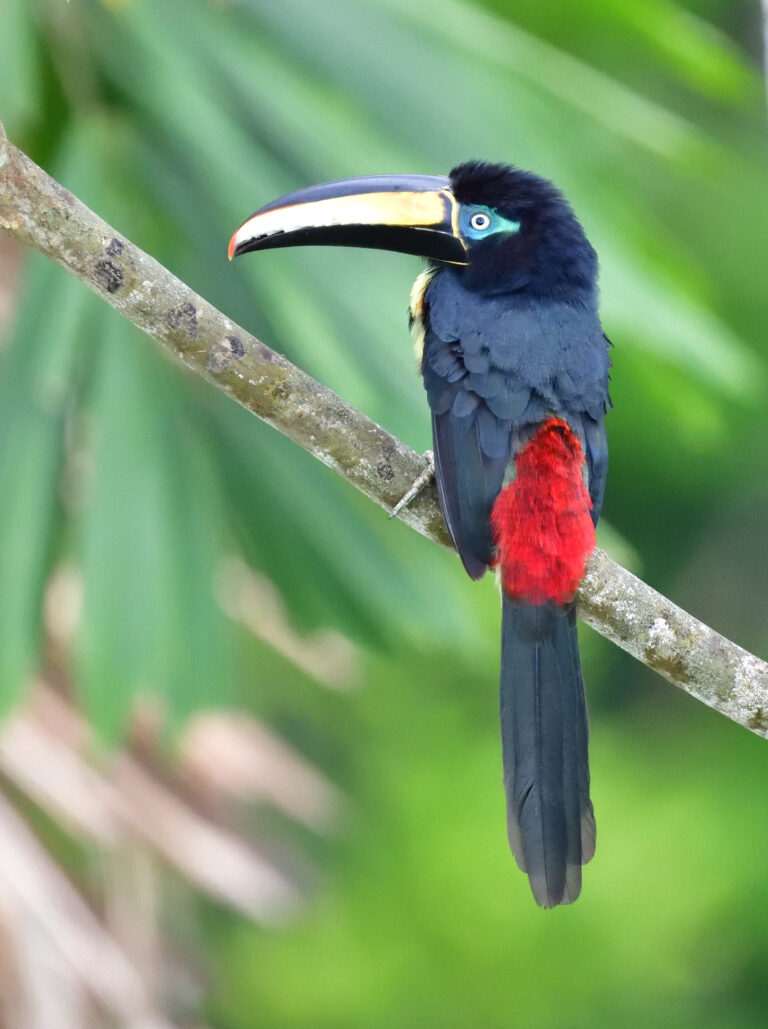
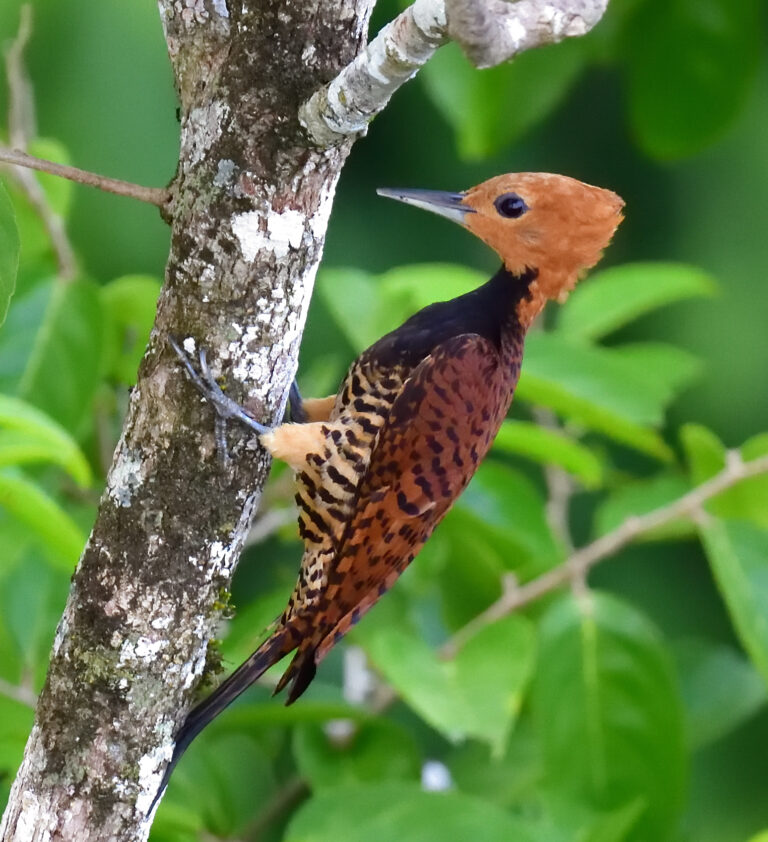
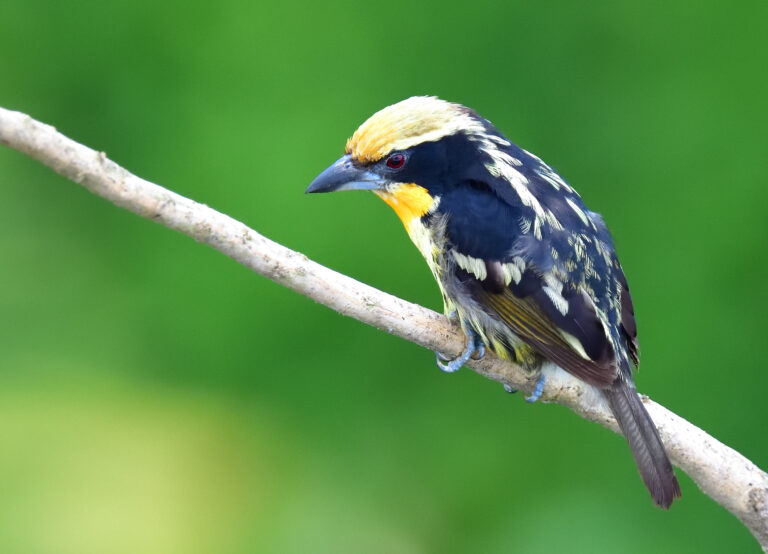
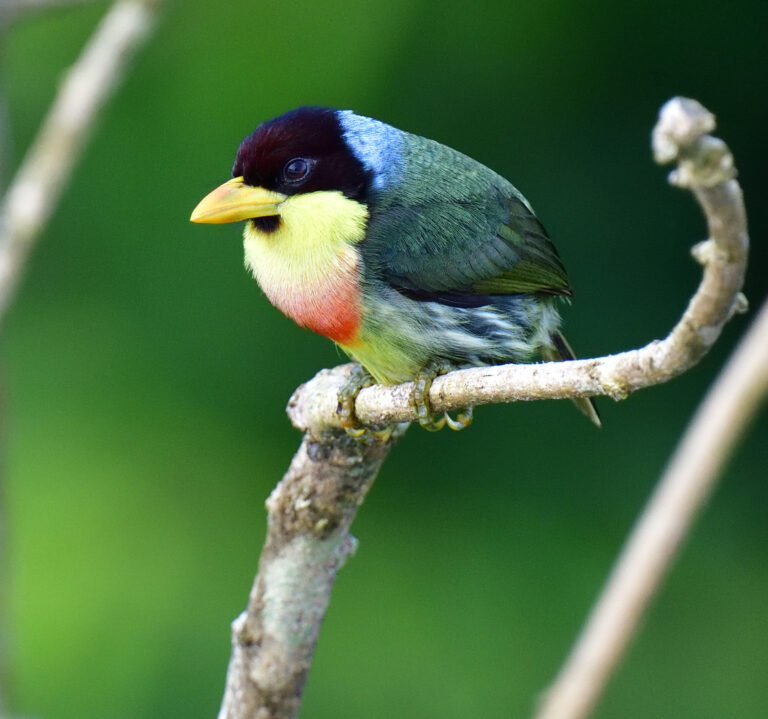
Once back down to earth, Shanshu takes us on a short detour from the trail into the jungle to show us a fabulous roosting Crested Owl! A few minutes later, he stops again, gestures to a horizontal branch and within seconds there’s a fantastic male Wire-tailed Manakin posing on the branch!
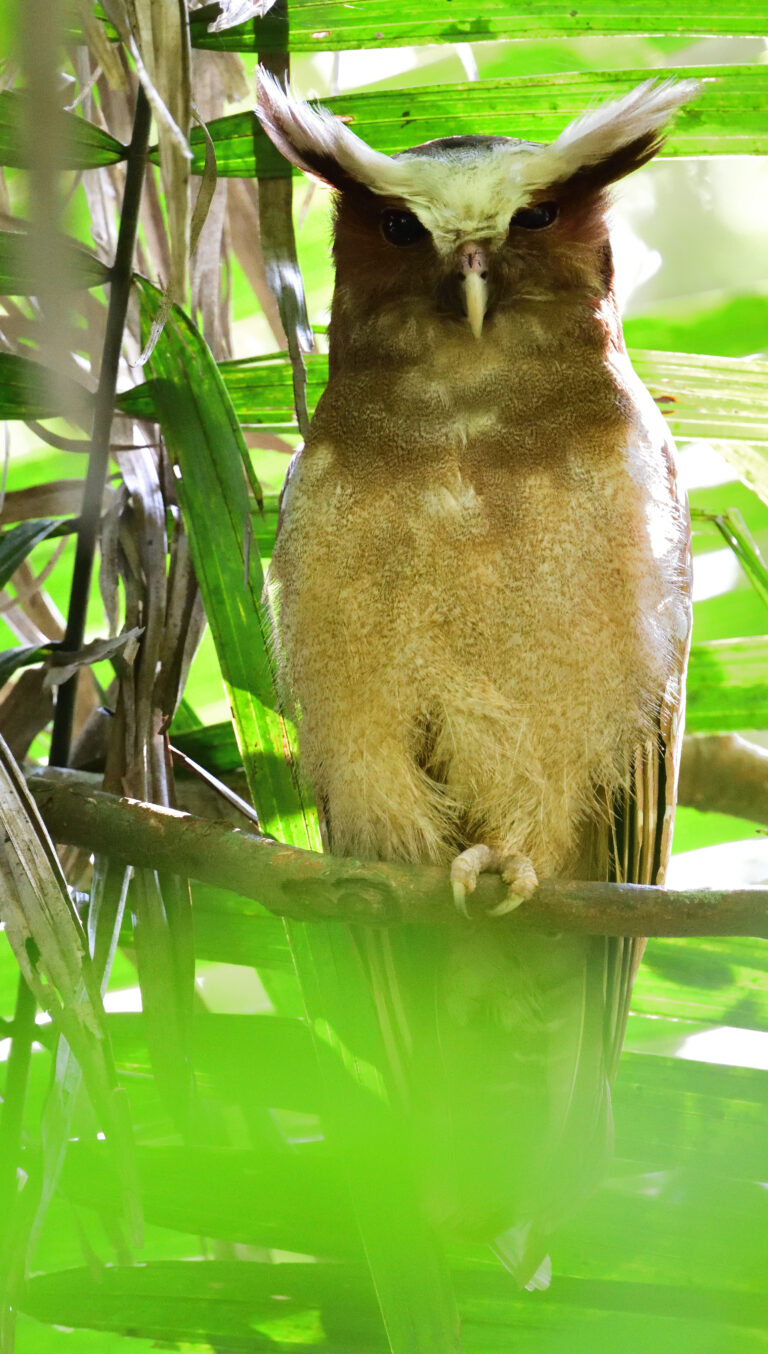
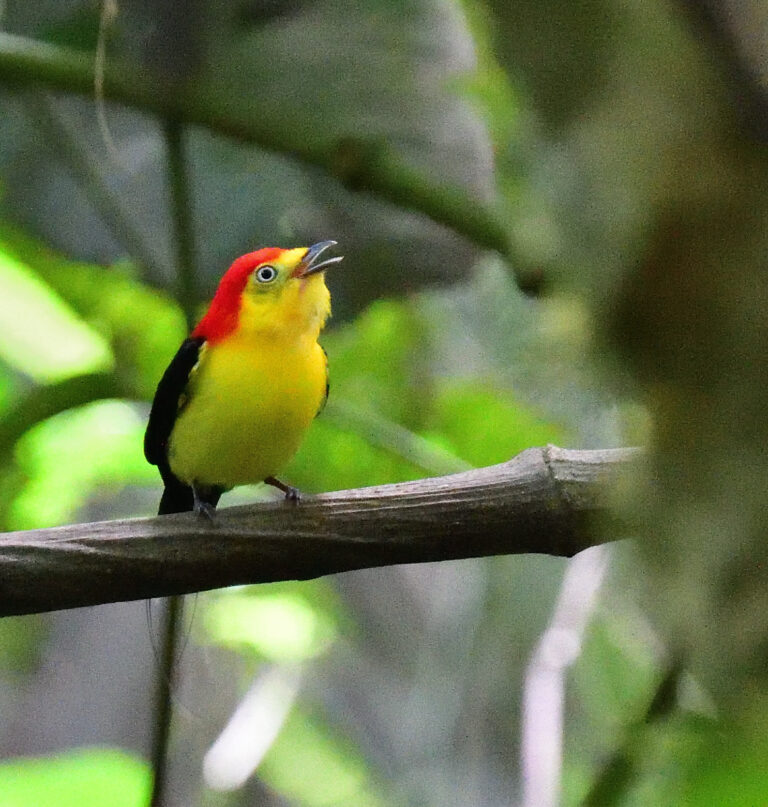
After a busy morning we return to the lodge to chill out with a drink on the terrace overlooking the lake, while watching a family of squealing Giant River Otters!
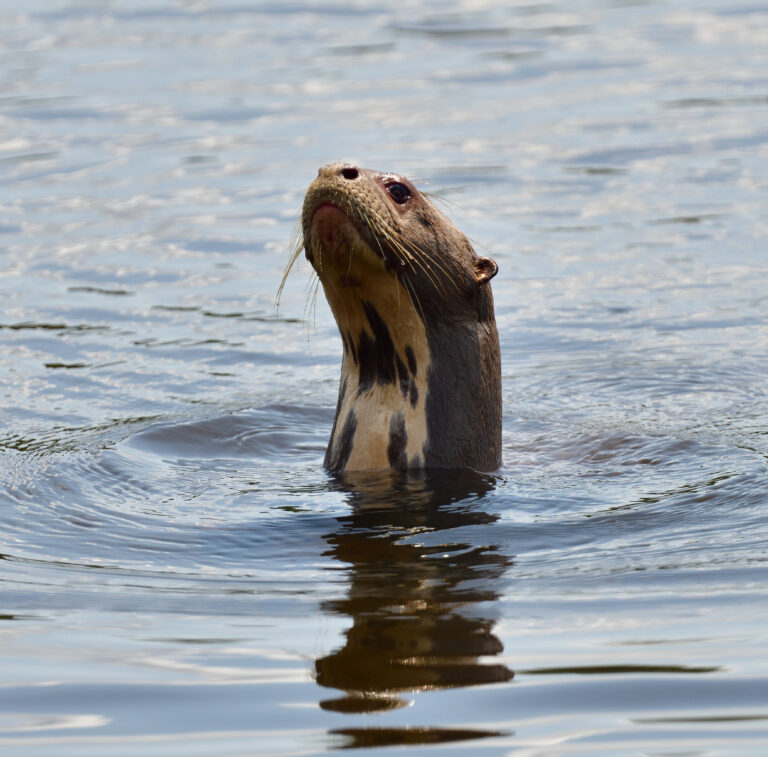
We head out again around 4pm for a boat ride into the flooded forest, spotting Fork-tailed Palm Swift, Straight-billed Woodcreeper, Buff-breasted Wren, a male Spot-backed Antbird, and a group of bizarre and ungainly Hoatzins with flamboyant crests, plus Red Howler and Squirrel Monkeys.
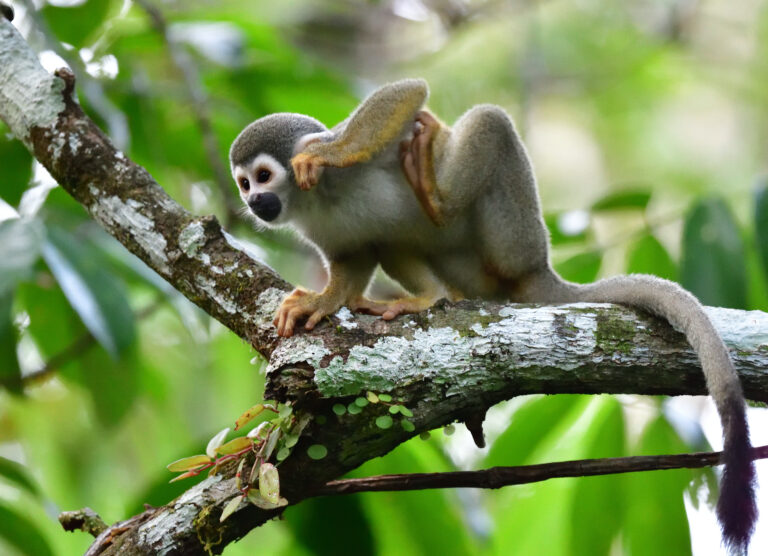
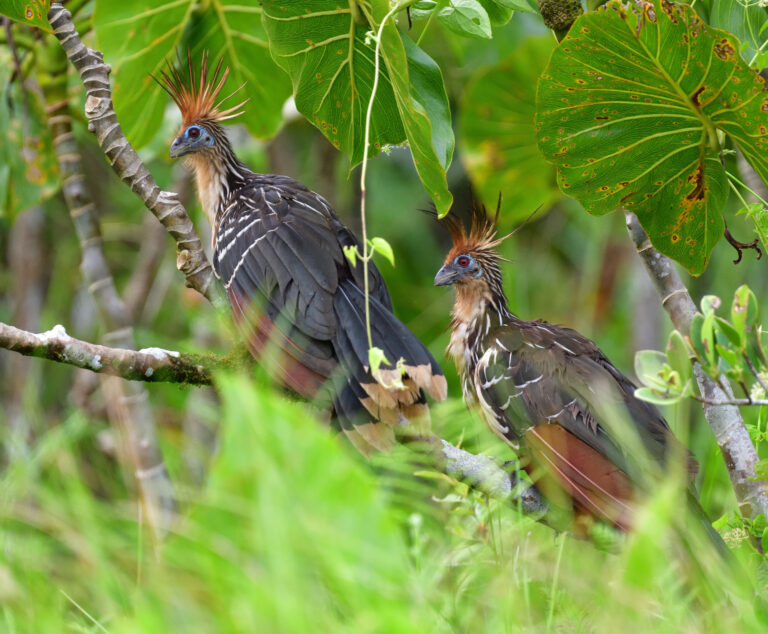
This morning we set off on another boat ride, finding a male Plumbeous Antbird and an impressive Long-billed Woodcreeper on the way to the Kapok tower, a 138 foot high platform built inside the canopy of a huge towering Kapok tree, and accessed by 197 steps! From the platform amongst the branches of this gargantuan tree we enjoy intimate eye level views of Capuchin Monkeys foraging just a few yards away, while a troop of Squirrel Monkeys move gracefully through the forest below us and a Three-toed Sloth hangs from a distant branch. Numerous bird sightings, many at very close range, include Roadside Hawk, Speckled Chachalaca, male Amazonian and Black-tailed Trogons, Chestnut Woodpecker, three Yellow-tufted Woodpeckers, Violaceous Jay, Chestnut-eared Aracari, Cinnamon Attila, Slender-footed Tyrannulet, Dusky-chested Flycatcher, Eastern Wood-Pewee, a male Spangled Cotinga, a male Green Honeycreeper, a pair of Purple Honeycreepers, Orange-bellied, Rufous-bellied and Thick-billed Euphonias, Opal-rumped, Opal-crowned, Green-and-gold, Fulvous-crested and Masked Crimson Tanagers, Buff-throated Saltator, Yellow-rumped Cacique and a tiny Dwarf Tyrant-Manakin.
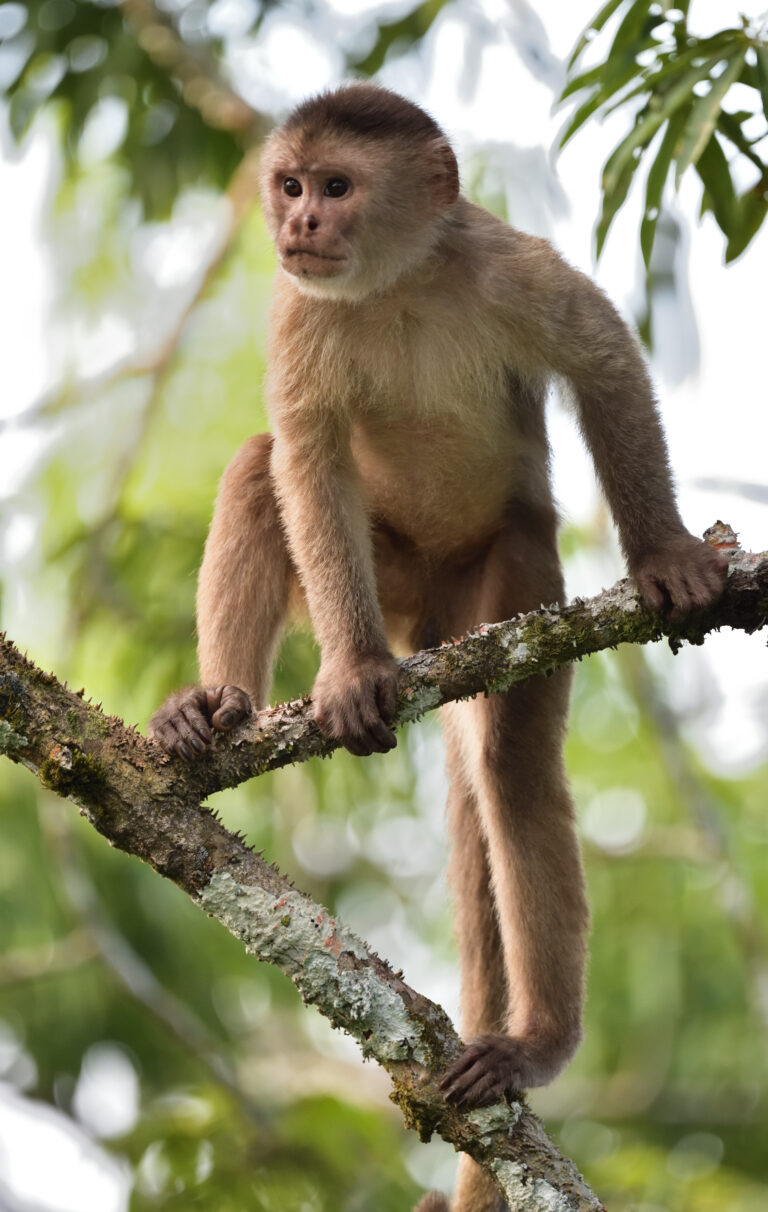
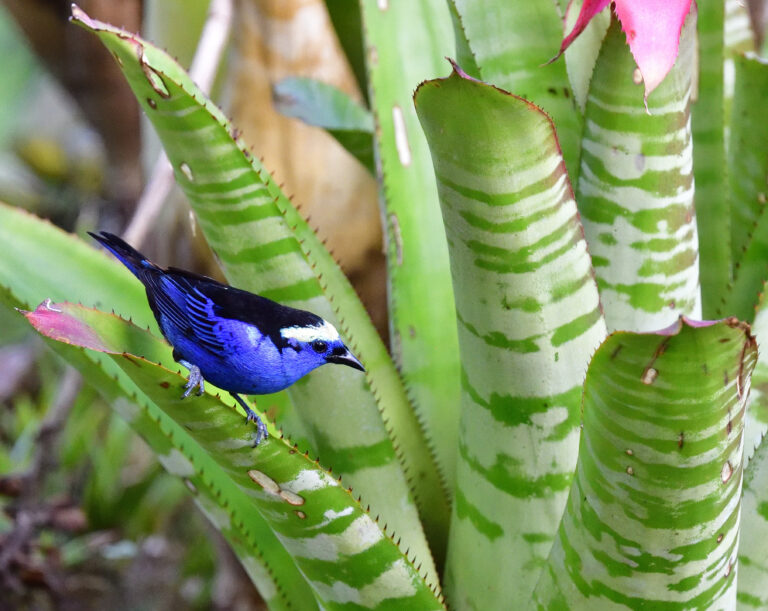
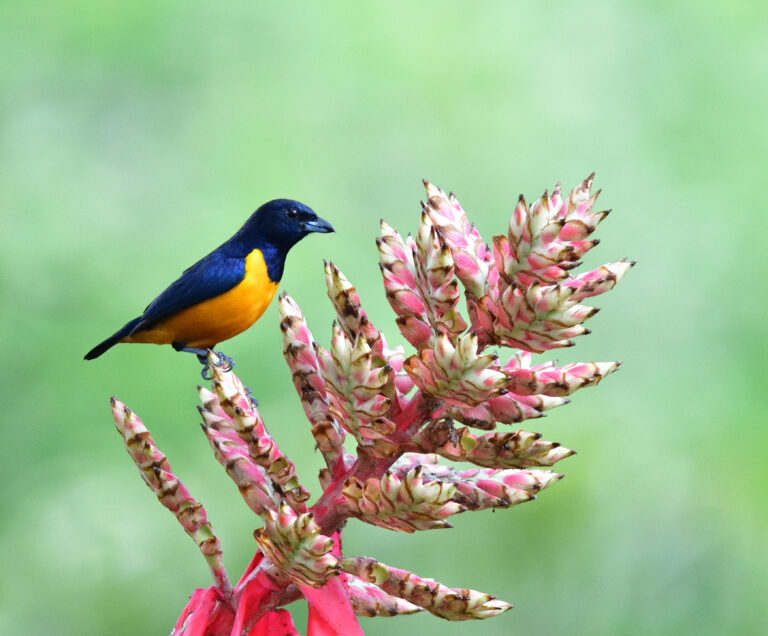
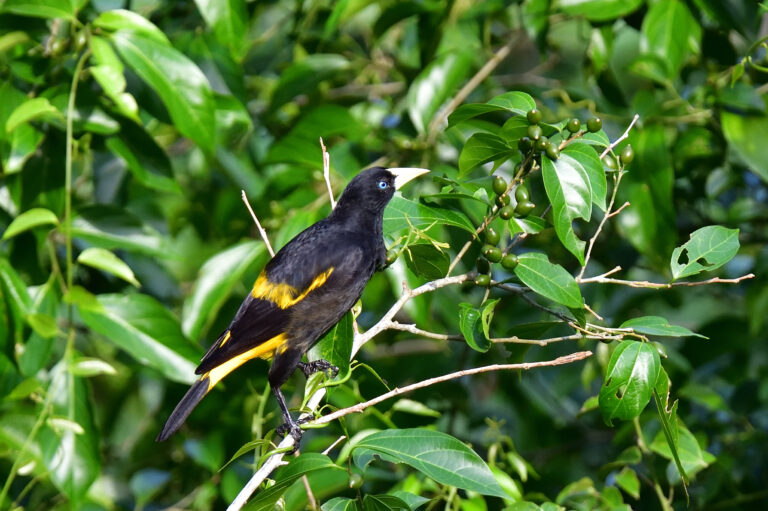
Back at ground level, we find Plain-throated Antwren, Ochre-bellied Flycatcher, Citron-bellied Attila, Coraya Wren, a female Scale-backed Antbird and a couple of Noisy Night Monkeys, quietly slumbering in a hole in a dead tree trunk.
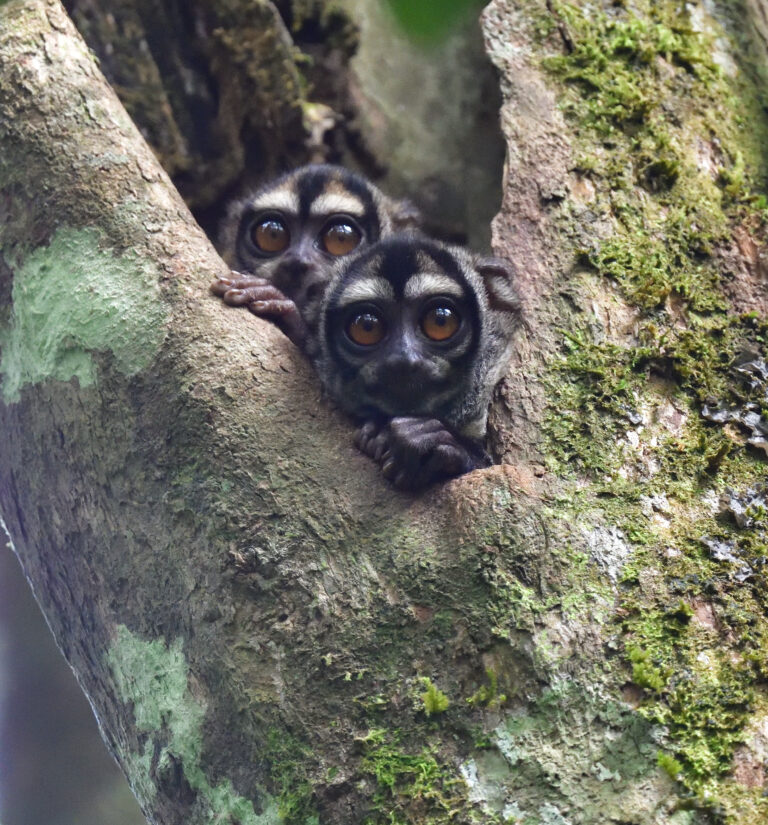
After lunch back at the lodge and watching a disastrously disappointing exit from the World Cup, we take a boat ride back to the Napo River, spotting Pale-vented Pigeon, Black-capped Donacobius and three Hoatzins along the way. Along the riverbank, we find Social Flycatcher, Greater Ani, Scarlet-crowned Barbet, the understated Drab Water Tyrant, a pair of smart Pied Lapwings and a group of Black-fronted Nunbirds, strangely named as they are completely black! By 6pm, the sun has set across the river, creating a rosy-pink glow on the water and in the sky to the west.
It’s our last full day at Sacha Lodge, so we set off early by boat, spotting a Ringed Kingfisher at the edge of ‘our’ lake. Back at the Napo River, we board a small motorboat for a trip downstream to a river cliff visited by numerous parrots to extract minerals to aid their digestion, while hoping to find Amazonian Umbrellabird along the way. Just before seven, Juan Carlos raises a hand to signal the driver to cut the engine, as we have an umbrellabird perched high in a tree on the riverbank, bingo! We also see Yellow-headed Caracara here and then further downstream at the ‘clay lick’, the riverside trees are full of noisy Mealy, Blue-headed and Yellow-crowned Parrots as well as Dusky-headed Parakeets, while a nearby treetop has four Red Howler Monkeys. Landing on a small uninhabited island in the river, we find new birds like White-bellied and Dark-breasted Spinetails, a pair of Ladder-tailed Nightjars, Eastern Kingbird, Oriole Blackbird, Chestnut-bellied and Caqueta Seedeaters, Blue-grey Saltator and best of all by far, the rare Olive-spotted Hummingbird which only occurs in Ecuador on these islands along the Napo River! Meanwhile, nine squawking Blue-and-yellow Macaws also fly over here. Moving on to a second island we find Cattle Tyrant, Spotted Tody Flycatcher, Fuscous Flycatcher, Swallow-winged Puffbirds, a lively pair of Little Woodpeckers, the fluorescent Orange-backed Troupial and a secretive male Castelnau’s Antshrike.
Back in the motorboat, following a side creek, we find huge Blue Morpho butterflies, plus Crane Hawk, Masked Tityra and Grey-capped Flycatcher. Just as we arrive back at the lodge, torrential rain begins and continues throughout the afternoon, bringing a halt to any further birding today.
This morning we leave the lodge by paddleboat before first light and then board a motorboat upriver back to Coca. After all the rain, a heavy mist hangs over the river, making it a hazardous journey through the ‘minefield’ of sunken tree trunks which litter the river. Our driver steers us skillfully through without any mishaps, while we add Striated Heron and Osprey to the bird list en route to Coca, where a small coach transfers us to the airport for a short flight back to Quito, with spectacular views of the snowy Antisana volcano as we approach the capital up in the Andes.
Our base for the night is the cosy Casa de Campo Tababela, a homely residence with quirky décor where the owner has really gone to town with a multitude of flamboyant Christmas decorations, which must have taken hours to arrange! Garden birds here include Eared Dove, Sparkling Violetear, Blue-and-white Swallow, Streak-throated Bush Tyrant, Black Phoebe, Vermillion Flycatcher, Cinereous Conebill, Golden-rumped Euphonia and Saffron Finch.
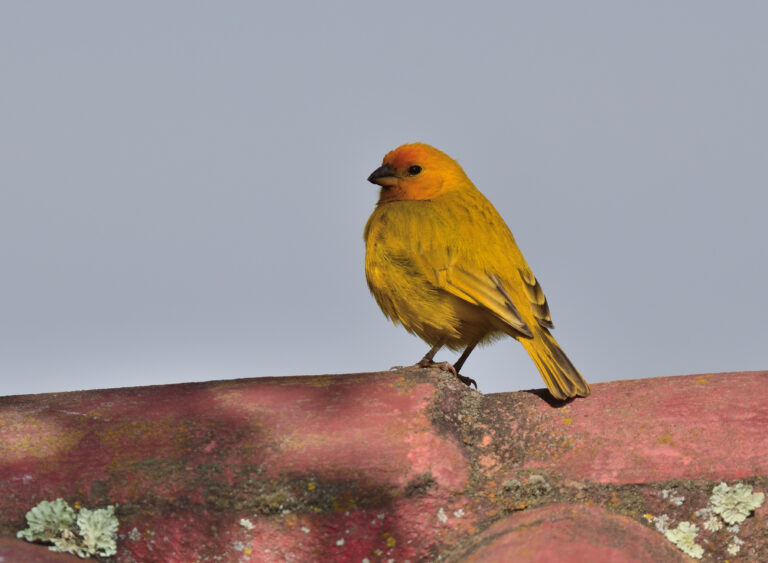
By now we had seen 360 different birds including five species of antpitta, eight toucans, ten woodpeckers, 35 different tanagers and 36 species of hummingbirds!
